OVHcloud VPS And Dedicated Servers For WHMCS
(→Common Problems) |
|||
| (89 intermediate revisions by 5 users not shown) | |||
| Line 1: | Line 1: | ||
| + | {{DISPLAYTITLE:OVH VPS & Dedicated Servers For WHMCS}} | ||
<meta name="google-site-verification" content="0jeeeHr47-Mrg-FashhD6uEffLru8OjaypiwaAGviDs" /> | <meta name="google-site-verification" content="0jeeeHr47-Mrg-FashhD6uEffLru8OjaypiwaAGviDs" /> | ||
| − | <meta name="keywords" content="ovh vps dedicated servers for whmcs, ovh vps dedicated configuration, ovh vps dedicated management, ovh vps dedicated installation, ovh vps dedicated guide, modulesgarden ovh vps dedicated, ovh vps dedicated wiki, ovh vps dedicated tutorial, ovh vps dedicated tips, | + | <meta name="keywords" content="ovh vps dedicated servers for whmcs, ovh vps dedicated servers configuration, ovh vps dedicated servers management, ovh vps dedicated servers installation, ovh vps dedicated servers guide, modulesgarden ovh vps dedicated servers, ovh vps dedicated servers wiki, ovh vps dedicated servers tutorial, ovh vps dedicated servers tips, ovh vps dedicated servers module wiki, ovh vps dedicated servers common problems, about ovh vps dedicated servers, ovh vps dedicated servers documentation, ovh vps dedicated servers faq, ovh vps dedicated servers help"></meta> |
| − | <meta name="description" content="ModulesGarden Wiki Contains All The Information You Need About The OVH VPS & Dedicated Servers | + | <meta name="description" content="ModulesGarden Wiki Contains All The Information You Need About The OVH VPS & Dedicated Servers For WHMCS Module."></meta> |
| − | + | =About [https://www.modulesgarden.com/products/whmcs/ovh-vps-and-dedicated-servers OVH VPS & Dedicated Servers For WHMCS]= | |
| − | =About [https://www.modulesgarden.com/products/whmcs/ovh-vps-and-dedicated-servers OVH VPS & Dedicated Servers | + | |
{| | {| | ||
| − | |style="padding: 10px 0px 10px 0px;"|'''OVH VPS & Dedicated Servers For WHMCS''' | + | |style="padding: 10px 0px 10px 0px;"|'''OVH VPS & Dedicated Servers For WHMCS''' will let you automatically supply VPS and dedicated servers powered by OVH, as well as So you Start and Kimsufi.<br /> |
| − | The module will | + | The module will allow your clients not only to remotely control the status of a machine, but also access the KVM and IMPI console, and update reverse DNS paths.<br /> |
| − | + | In addition, you will easily decide whether an existing server can be reused by another customer, in case the previous one no longer needs it. | |
|} | |} | ||
<!-- fixed --> | <!-- fixed --> | ||
*'''Admin Area Features:''' | *'''Admin Area Features:''' | ||
{| | {| | ||
| − | |style="padding: 10px 0px 0px 30px;"|✔ Create/Suspend/Unsuspend/Terminate Server | + | |style="padding: 10px 0px 0px 30px;"|✔ Create/Suspend/Unsuspend/Terminate/Renew Server |
|} | |} | ||
{| | {| | ||
| − | |style="padding: 0px 0px 0px 30px;"|✔ | + | |style="padding: 0px 0px 0px 30px;"|✔ Power On/Power Off/Reboot Server |
|} | |} | ||
{| | {| | ||
| − | |style="padding: 0px 0px 0px 30px;"|✔ | + | |style="padding: 0px 0px 0px 30px;"|✔ Reboot Server In Rescue Mode |
|} | |} | ||
{| | {| | ||
| − | |style="padding: 0px 0px 0px 30px;"|✔ | + | |style="padding: 0px 0px 0px 30px;"|✔ Reinstall Server |
|} | |} | ||
{| | {| | ||
| − | |style="padding: 0px 0px 0px 30px;"|✔ | + | |style="padding: 0px 0px 0px 30px;"|✔ Access KVM/IPMI Console (OVH) |
|} | |} | ||
{| | {| | ||
| − | |style="padding: 0px 0px 0px 30px;"|✔ | + | |style="padding: 0px 0px 0px 30px;"|✔ View Server Status And Details |
|} | |} | ||
{| | {| | ||
| − | |style="padding: 0px 0px 0px 30px;"|✔ | + | |style="padding: 0px 0px 0px 30px;"|✔ Monitor Server Protocols Status (VPS) |
|} | |} | ||
{| | {| | ||
| − | |style="padding: 0px 0px 0px 30px;"|✔ | + | |style="padding: 0px 0px 0px 30px;"|✔ View/Create/Restore/Delete Snapshots (VPS) |
|} | |} | ||
{| | {| | ||
| − | |style="padding: 0px 0px 0px 30px;"|✔ View | + | |style="padding: 0px 0px 0px 30px;"|✔ View Assigned IP Addresses And Update Reverse DNS Paths |
|} | |} | ||
{| | {| | ||
| − | |style="padding: 0px 0px 0px 30px;"|✔ View | + | |style="padding: 0px 0px 0px 30px;"|✔ View Assigned Disks With Bandwidth And Space Limit |
|} | |} | ||
{| | {| | ||
| − | |style="padding: 0px 0px 0px 30px;"|✔ View | + | |style="padding: 0px 0px 0px 30px;"|✔ View Traffic Statistics Graph (Dedicated Servers) |
|} | |} | ||
{| | {| | ||
| − | |style="padding: 0px 0px 0px 30px;"|✔ | + | |style="padding: 0px 0px 0px 30px;"|✔ Configure Product Details For: |
|} | |} | ||
{| | {| | ||
| − | |style="padding: 0px 0px 0px | + | |style="padding: 0px 0px 0px 45px;"|✔ VPS |
|} | |} | ||
{| | {| | ||
| − | |style="padding: 0px 0px 0px | + | |style="padding: 0px 0px 0px 45px;"|✔ Dedicated Server |
|} | |} | ||
{| | {| | ||
| − | |style="padding: 0px 0px 0px 30px;"|✔ | + | |style="padding: 0px 0px 0px 30px;"|✔ Choose Features Available In Client Area |
|} | |} | ||
{| | {| | ||
| − | |style="padding: 0px 0px 0px | + | |style="padding: 0px 0px 0px 30px;"|✔ Generate Configurable Options |
|} | |} | ||
{| | {| | ||
| − | |style="padding: 0px 0px 0px | + | |style="padding: 0px 0px 0px 30px;"|✔ Choose Welcome Email, Password Reset And Rescue Reboot Email Templates |
|} | |} | ||
{| | {| | ||
| − | |style="padding: 0px 0px 0px | + | |style="padding: 0px 0px 0px 30px;"|✔ Configure Email Piping |
|} | |} | ||
{| | {| | ||
| − | |style="padding: 0px 0px 0px | + | |style="padding: 0px 0px 0px 30px;"|✔ Choose Usable OVH Server Location, Country And Type |
|} | |} | ||
{| | {| | ||
| − | |style="padding: 0px 0px 0px | + | |style="padding: 0px 0px 0px 30px;"|✔ Choose Existing Servers To Be Reused By Another Client |
|} | |} | ||
{| | {| | ||
| − | |style="padding: 0px 0px | + | |style="padding: 0px 0px 10px 30px;"|✔ View Servers Logs |
|} | |} | ||
| + | |||
| + | *'''Client Area Features:''' | ||
{| | {| | ||
| − | |style="padding: 0px 0px | + | |style="padding: 10px 0px 0px 30px;"|✔ Power On/Power Off/Reboot Server |
|} | |} | ||
{| | {| | ||
| − | |style="padding: 0px 0px 0px | + | |style="padding: 0px 0px 0px 30px;"|✔ Reboot Server In Rescue Mode |
|} | |} | ||
{| | {| | ||
| − | |style="padding: 0px 0px 0px | + | |style="padding: 0px 0px 0px 30px;"|✔ Reinstall Server |
|} | |} | ||
{| | {| | ||
| − | |style="padding: 0px 0px 0px | + | |style="padding: 0px 0px 0px 30px;"|✔ Access KVM/IPMI Console (OVH) |
|} | |} | ||
{| | {| | ||
| − | |style="padding: 0px 0px 0px | + | |style="padding: 0px 0px 0px 30px;"|✔ View Server Status And Details |
|} | |} | ||
{| | {| | ||
| − | |style="padding: 0px 0px 0px | + | |style="padding: 0px 0px 0px 30px;"|✔ View/Create/Restore/Delete Snapshots (VPS) |
|} | |} | ||
{| | {| | ||
| − | |style="padding: 0px 0px 0px | + | |style="padding: 0px 0px 0px 30px;"|✔ View Assigned Disks With Bandwidth And Space Limit (VPS) |
|} | |} | ||
{| | {| | ||
| − | |style="padding: 0px 0px 0px | + | |style="padding: 0px 0px 0px 30px;"|✔ View Assigned IP Addresses And Update Reverse DNS Paths |
|} | |} | ||
{| | {| | ||
| − | |style="padding: 0px 0px 0px 30px;"|✔ | + | |style="padding: 0px 0px 0px 30px;"|✔ View Traffic Statistics Graph (Dedicated Servers) |
|} | |} | ||
{| | {| | ||
| − | |style="padding: 0px 0px 0px | + | |style="padding: 0px 0px 0px 30px;"|✔ Choose Server Parameters During Order |
|} | |} | ||
{| | {| | ||
| − | |style="padding: 0px 0px | + | |style="padding: 0px 0px 10px 30px;"|✔ Receive Email Notifications After Server Creation, Password Reset And Rescue Reboot |
|} | |} | ||
| + | |||
| + | *'''Configurable Options:''' | ||
{| | {| | ||
| − | |style="padding: 0px 0px | + | |style="padding: 10px 0px 0px 30px;"|✔ VPS: |
|} | |} | ||
{| | {| | ||
| − | |style="padding: 0px 0px 0px 45px;"|✔ | + | |style="padding: 0px 0px 0px 45px;"|✔ Solution Type |
|} | |} | ||
{| | {| | ||
| − | |style="padding: 0px 0px 0px 45px;"|✔ | + | |style="padding: 0px 0px 0px 45px;"|✔ Operating System Template |
|} | |} | ||
{| | {| | ||
| − | |style="padding: 0px 0px 0px 45px;"|✔ | + | |style="padding: 0px 0px 0px 45px;"|✔ Data Center Location |
|} | |} | ||
{| | {| | ||
| − | |style="padding: 0px 0px 0px 45px;"|✔ | + | |style="padding: 0px 0px 0px 45px;"|✔ Snapshot |
|} | |} | ||
{| | {| | ||
| − | |style="padding: 0px 0px 0px 45px;"|✔ | + | |style="padding: 0px 0px 0px 45px;"|✔ License |
|} | |} | ||
{| | {| | ||
| − | |style="padding: 0px 0px 0px | + | |style="padding: 0px 0px 0px 45px;"|✔ Solution Type, Operating System And Application (As Single Option) |
|} | |} | ||
{| | {| | ||
| − | |style="padding: 0px 0px 0px | + | |style="padding: 0px 0px 0px 30px;"|✔ Dedicated Servers: |
|} | |} | ||
{| | {| | ||
| − | |style="padding: 0px 0px 0px | + | |style="padding: 0px 0px 0px 45px;"|✔ Operating System Template |
|} | |} | ||
{| | {| | ||
| − | |style="padding: 0px 0px | + | |style="padding: 0px 0px 10px 45px;"|✔ Operating System Language |
|} | |} | ||
| + | |||
| + | *'''General Info:''' | ||
{| | {| | ||
| − | |style="padding: | + | |style="padding: 10px 0px 0px 30px;"|✔ Integrated With <u>Server Allocator For WHMCS</u> - Automatic Assignment Of Most Suitable Servers To Products [https://www.modulesgarden.com/products/whmcs/server-allocator (read more)] |
|} | |} | ||
{| | {| | ||
| − | |style="padding: 0px 0px 0px 30px;"|✔ | + | |style="padding: 0px 0px 0px 30px;"|✔ Supports OVH VPS And Dedicated Servers |
|} | |} | ||
{| | {| | ||
| − | |style="padding: 0px 0px 0px 30px;"|✔ | + | |style="padding: 0px 0px 0px 30px;"|✔ Supports "So you Start" And "Kimsufi" Brands |
|} | |} | ||
{| | {| | ||
| − | |style="padding: 0px 0px | + | |style="padding: 0px 0px 0px 30px;"|✔ Supports Plan Upgrades (VPS) |
|} | |} | ||
| − | |||
| − | |||
{| | {| | ||
| − | |style="padding: | + | |style="padding: 0px 0px 0px 30px;"|✔ Multi-Language Support |
|} | |} | ||
{| | {| | ||
| − | |style="padding: 0px 0px 0px 30px;"|✔ | + | |style="padding: 0px 0px 0px 30px;"|✔ Supports PHP 7.2 Up To PHP 7.4 |
|} | |} | ||
{| | {| | ||
| − | |style="padding: 0px 0px 0px 30px;"|✔ | + | |style="padding: 0px 0px 0px 30px;"|✔ Supports WHMCS Themes "Six" And "Twenty-One" |
|} | |} | ||
{| | {| | ||
| − | |style="padding: 0px 0px 0px 30px;"|✔ | + | |style="padding: 0px 0px 0px 30px;"|✔ Supports WHMCS V7.10 And Later |
|} | |} | ||
{| | {| | ||
| − | |style="padding: | + | |style="padding: 0px 0px 30px 30px;"|✔ Easy Module Upgrade To [https://www.modulesgarden.com/products/whmcs/ovh-vps-and-dedicated-servers#open-source-version Open Source Version] |
|} | |} | ||
| + | |||
| + | =Installation and Configuration= | ||
{| | {| | ||
| − | |style="padding: 0px 0px | + | |style="padding: 10px 0px 30px 0px;"|'''This tutorial will show you how to successfully install and configure OVH VPS & Dedicated Servers For WHMCS.''' <br /> |
| + | We will guide you step by step through the whole installation and configuration process. | ||
|} | |} | ||
| + | ==Installation== | ||
{| | {| | ||
| − | |style="padding: 0px | + | |style="padding: 10px 0px 20px 15px;"|'''1. Log in to our client area and download the module.''' |
|} | |} | ||
{| | {| | ||
| − | |style="padding: 0px 0px | + | |style="padding: 0px 0px 20px 25px;"|[[File:OVH_1.png]] |
|} | |} | ||
{| | {| | ||
| − | |style="padding: 0px 0px | + | |style="padding: 0px 0px 15px 15px;"|'''2. Upload and extract the extension into the main WHMCS directory.<br /> |
| + | Extracted files in your WHMCS directory should look like this: | ||
|} | |} | ||
{| | {| | ||
| − | |style="padding: 0px 0px | + | |style="padding: 0px 0px 20px 25px;"|[[File:OVH_2.png]] |
|} | |} | ||
{| | {| | ||
| − | |style="padding: 0px 0px | + | |style="padding: 0px 0px 15px 15px;"|'''3. When you install OVH VPS & Dedicated Servers For WHMCS for the first time, you have to rename the '' 'license_RENAME.php' '' file.'''<br /> |
| + | The file is located in '' 'modules/servers/OvhVpsAndDedicated/license_RENAME.php'. '' Rename it from '' 'license_RENAME.php' '' to '' 'license.php'. '' | ||
|} | |} | ||
{| | {| | ||
| − | |style="padding: 0px 0px | + | |style="padding: 0px 0px 20px 25px;"|[[File:OVH_3.png]] |
|} | |} | ||
{| | {| | ||
| − | |style="padding: 0px 0px | + | |style="padding: 0px 0px 15px 15px;"|'''4. In order to configure your license key, you have to edit the previously renamed '' 'license.php' '' file.'''<br /> |
| + | Enter your license key between the quotation marks as presented on the following screen.<br /> | ||
| + | You can find your license key in our client area → '' 'My Products'. '' | ||
|} | |} | ||
{| | {| | ||
| − | |style="padding: 0px 0px | + | |style="padding: 0px 0px 20px 25px;"|[[File:OVH_4.png]] |
|} | |} | ||
{| | {| | ||
| − | |style="padding: 0px 0px | + | |style="padding: 0px 0px 15px 15px;"|'''5. Now, set up the '' 'storage' '' folders as recursively writable.'''<br /> |
| + | These folders are available at: | ||
| + | #'' '/your_whmcs/modules/servers/OvhVpsAndDedicated/' '' and | ||
| + | #'' '/your_whmcs/modules/addons/OvhVpsAndDedicated/' '' | ||
|} | |} | ||
{| | {| | ||
| − | |style="padding: 0px 0px | + | |style="padding: 0px 0px 20px 25px;"|[[File:OVH_4_1.png]] |
|} | |} | ||
{| | {| | ||
| − | |style="padding: | + | |style="padding: 0px 0px 30px 15px;"|'''6. The last step is setting up the cron job.'''<br /> |
| + | |||
| + | * Mail cron - will be used to send emails to clients after Server creation, reinstallation and entering the rescue mode.<br/>You will find more information on this topic in the product configuration section. We suggest the cron to run every 5 minutes: | ||
| + | <pre>php -q /your_whmcs/modules/servers/OvhVpsAndDedicated/cron/cron.php mail:run</pre> | ||
| + | |||
| + | Remember to replace '' 'your_whmcs' '' with your WHMCS root path. | ||
|} | |} | ||
| + | |||
| + | ==Activation of Addon== | ||
{| | {| | ||
| − | |style="padding: 0px | + | |style="padding: 10px 0px 15px 15px;"|'''7. Now you have to activate the module in your WHMCS system.'''<br /> |
| + | Log in to your WHMCS admin area. Click '' 'System Settings' '' and find '' 'Addon Modules'. ''<br/> | ||
| + | Afterwards, find '' 'OVH VPS And Dedicated Servers For WHMCS' '' and press the '' 'Activate' '' button. | ||
|} | |} | ||
{| | {| | ||
| − | |style="padding: 0px 0px | + | |style="padding: 0px 0px 20px 25px;"|[[File:OVH_5.png]] |
|} | |} | ||
{| | {| | ||
| − | |style="padding: 0px 0px | + | |style="padding: 0px 0px 15px 15px;"|'''8. In the next step you need to permit access to this module.'''<br /> |
| + | To do so, click on the '' 'Configure' '' button, tick the desired admin roles and press '' 'Save Changes'. ''<br /> | ||
|} | |} | ||
| − | |||
| − | |||
{| | {| | ||
| − | |style="padding: | + | |style="padding: 0px 0px 20px 25px;"|[[File:OVH_6.png]] |
|} | |} | ||
{| | {| | ||
| − | |style="padding: | + | |style="padding: 0px 0px 30px 15px;"|'''9. OVH VPS And Dedicated Servers For WHMCS has been successfully installed!'''<br /> |
| + | Access the addon under '' 'Addons' '' → '' 'OVH VPS And Dedicated'. '' | ||
|} | |} | ||
| + | |||
| + | ==Configuration of Server== | ||
{| | {| | ||
| − | |style="padding: 0px | + | |style="padding: 10px 0px 15px 15px;"|'''10. Now, we will show you how to configure a new product.'''<br /> |
| + | Go to '' 'System Settings' '' → '' 'Servers' '' and press '' 'Add New Server' ''. | ||
|} | |} | ||
{| | {| | ||
| − | |style="padding: 0px 0px | + | |style="padding: 0px 0px 20px 25px;"|[[File:OVH_7.png]] |
|} | |} | ||
{| | {| | ||
| − | |style="padding: 0px 0px | + | |style="padding: 0px 0px 15px 15px;"|'''11. Next, enter your server name and select '' 'OVH' '' from the '' 'Type' '' field.<br/> |
| + | Now, provide your: | ||
| + | *'''Application Key''' | ||
| + | *'''Application Secret''' | ||
| + | *'''Consumer Key'''<br/> | ||
| + | Then select '''Location''' and '''Country''' corresponding with the server offered by the administrator and finally, select the '''OVH Server Type''' (VPS/Dedicated). | ||
| + | <br/> ''' ''Note:''' For "So You Start" and "Kimsufi" select 'Dedicated'. ''<br/> | ||
| + | Check the connection when ready and, if it is successful, save the changes. <br/> | ||
|} | |} | ||
{| | {| | ||
| − | |style="padding: 0px 0px | + | |style="padding: 0px 0px 20px 25px;"|[[File:OVH_8.png]] |
|} | |} | ||
{| | {| | ||
| − | |style="padding: 0px 0px | + | |style="padding: 0px 0px 15px 15px;"|'''API details''' are generated depending on the location where you own the OVH account. These might be: |
| + | *https://api.us.ovhcloud.com/createApp/ ''(US)'' | ||
| + | *https://api.ovh.com/createApp/ | ||
| + | *https://eu.api.ovh.com/createApp/ | ||
| + | *https://ca.api.ovh.com/createApp/ | ||
| + | *https://eu.api.soyoustart.com/createApp/ | ||
| + | *https://ca.api.soyoustart.com/createApp/ | ||
| + | *https://eu.api.kimsufi.com/createApp/ | ||
| + | *https://ca.api.kimsufi.com/createApp/ | ||
| + | |||
| + | To create an application, please move directly [https://api.ovh.com/createToken/ here] and create the necessary keys.<br/> | ||
| + | In case you encounter any issues with generating your API details, please contact your provider. To learn more about API, please refer to the [https://docs.ovh.com/gb/en/customer/first-steps-with-ovh-api/ documentation]. | ||
|} | |} | ||
{| | {| | ||
| − | |style="padding: 0px 0px | + | |style="padding: 0px 0px 20px 25px;"|[[File:OVH_8_1.png]] |
|} | |} | ||
{| | {| | ||
| − | |style="padding: 0px 0px | + | |style="padding: 0px 0px 15px 15px;"|You may also skip the '' 'Consumer Key' '' field in the server configuration ''(Application Key and Secret must be provided)''.<br/> |
| + | After saving the changes, the module will redirect you, in such case, to your provider's page where the key can be generated at once. Please log in and select '' 'Unlimited' '' in the key validity field.<br/> | ||
| + | The '' 'Consumer Key ' '' will be automatically generated and entered in the appropriate field in the server's configuration page in the module. | ||
|} | |} | ||
{| | {| | ||
| − | |style="padding: 0px 0px | + | |style="padding: 0px 0px 20px 25px;"|[[File:OVH_8_3.png]] |
|} | |} | ||
{| | {| | ||
| − | |style="padding: 0px 0px | + | |style="padding: 0px 0px 20px 15px;"|'''12. It is time to create a server group. To do so, click on '' 'Create New Group'.''''' |
|} | |} | ||
| − | |||
| − | |||
{| | {| | ||
| − | |style="padding: | + | |style="padding: 0px 0px 20px 25px;"|[[File:OVH_9.png]] |
|} | |} | ||
{| | {| | ||
| − | |style="padding: 0px 0px | + | |style="padding: 0px 0px 20px 15px;"|'''13. Enter a name, click on your previously created server, press '' 'Add' '' and afterward '' 'Save Changes'.''''' |
|} | |} | ||
{| | {| | ||
| − | |style="padding: | + | |style="padding: 0px 0px 30px 25px;"|[[File:OVH_9_1.png]] |
|} | |} | ||
| + | |||
| + | ==Configuration of Product== | ||
{| | {| | ||
| − | |style="padding: 0px | + | |style="padding: 10px 0px 15px 15px;"|'''15. In order to create and configure a product, go to '' 'System Settings' '' → '' 'Products/Services'.'''''<br /> |
| + | Click on '' 'Create a New Group'.'' | ||
|} | |} | ||
{| | {| | ||
| − | |style="padding: 0px 0px | + | |style="padding: 0px 0px 20px 25px;"|[[File:OVH_10.png]] |
|} | |} | ||
{| | {| | ||
| − | |style="padding: 0px 0px | + | |style="padding: 0px 0px 20px 15px;"|'''16. Enter your product group name and press '' 'Save Changes'. ''''' |
|} | |} | ||
| − | |||
| − | |||
{| | {| | ||
| − | |style="padding: | + | |style="padding: 0px 0px 20px 25px;"|[[File:OVH_11.png]] |
| − | + | ||
|} | |} | ||
| − | |||
{| | {| | ||
| − | |style="padding: | + | |style="padding: 0px 0px 15px 15px;"|'''17. Once you have a product group, you can create a new product.'''<br /> |
| + | To do so, first click on '' 'Create a New Product'.'' | ||
|} | |} | ||
{| | {| | ||
| − | |style="padding: 0px 0px 20px 25px;"|[[File: | + | |style="padding: 0px 0px 20px 25px;"|[[File:OVH_12.png]] |
|} | |} | ||
{| | {| | ||
| − | |style="padding: 0px 0px 15px 15px;"|''' | + | |style="padding: 0px 0px 15px 15px;"|'''18. Afterward, choose your product type, enter your product name and choose the product group from the dropdown menu. Press '' 'Continue'. '' '''<br /> |
| − | + | ||
|} | |} | ||
{| | {| | ||
| − | |style="padding: 0px 0px 20px 25px;"|[[File: | + | |style="padding: 0px 0px 20px 25px;"|[[File:OVH_13.png]] |
|} | |} | ||
{| | {| | ||
| − | |style="padding: 0px 0px 15px 15px;"|''' | + | |style="padding: 0px 0px 15px 15px;"|'''19. Now, go to the '' 'Module Settings' '' section, choose your previously created server group from the dropdown menu.'''<br /> |
| − | The | + | The module should automatically save and reload the settings. If not, click on the '' 'Save Changes' '' option manually.''' |
| − | ''''' | + | |
|} | |} | ||
{| | {| | ||
| − | |style="padding: 0px 0px 20px 25px;"|[[File: | + | |style="padding: 0px 0px 20px 25px;"|[[File:OVH_14.png]] |
|} | |} | ||
{| | {| | ||
| − | |style="padding: 0px 0px | + | |style="padding: 0px 0px 15px 15px;"|'''20. Now, you can start configuring the settings of the Server you sell.'''<br /> Bear in mind that the settings vary, depending on the server type selected.<br/> |
| + | Underneath we will describe the settings configuration for '' 'OVH VPS' '' and '' 'OVH Dedicated Servers' '' in details.<br/> Note that settings for '' 'So You Start' '' and '' 'Kimsufi' '' products are very much alike the '' 'OVH Dedicated Servers' '' once, so you may surely base on them while configuring these products. | ||
| + | |||
| + | '''OVH VPS''' configuration settings: | ||
| + | |||
| + | * '''Solution Type''' - choose from the available the one that will suit your needs the most | ||
| + | |||
| + | * '''Operating System''' - choose the OS, it can still be reinstalled at any time if such an option is enabled for clients | ||
| + | **GNU/Linux | ||
| + | **Windows (Cloud/Cloud RAM only) | ||
| + | |||
| + | * ''' License''' - you can select a license from the available ones | ||
| + | |||
| + | * '''Data Center Location''' - choose where the server shall be located on the OVH data center | ||
| + | |||
| + | * '''Payment Frequency''' - define the frequency of payments | ||
| + | |||
| + | * '''Prevent System Reinstall''' - enable if you want to block the OS reinstallation during the upgrade process | ||
| + | |||
| + | * '''Snapshot''' - decide if clients should be allowed to capture an image of the server at a given time. | ||
|} | |} | ||
{| | {| | ||
| − | |style="padding: 0px 0px | + | |style="padding: 0px 0px 20px 25px;"|[[File:OVH_15.png]] |
| − | + | ||
|} | |} | ||
{| | {| | ||
| − | |style="padding: 0px 0px | + | |style="padding: 0px 0px 15px 15px;"|'''OVH Dedicated Server''' configuration settings: |
| + | |||
| + | * '''Operation System Template''' - choose a template of an operation system to install | ||
| + | |||
| + | * '''Operating System Language''' - choose the language of an installed operation system | ||
| + | |||
| + | * '''Plan''' - check out the powerful line-up of dedicated servers and select the preferred solution | ||
| + | |||
| + | * '''Disks''' - customise your server by selecting one of the available disks | ||
| + | |||
| + | * '''Distribution License''' - choose the distribution license | ||
| + | |||
| + | * '''Application License''' - choose the application license | ||
| + | |||
| + | * '''Contract Duration''' - define the duration of the contract | ||
| + | |||
| + | * '''Memory''' - define the memory of your dedicated server | ||
| + | |||
| + | * '''vRack''' - choose up to 40 Gbps, on certain models, for increased speed | ||
| + | |||
| + | * '''Public Network''' - choose the preferred public network traffic | ||
| + | |||
| + | * '''Data Center Location''' - define where a server will be located on the OVH data center | ||
| + | |||
| + | * '''Payment Frequency''' - define the frequency of payments | ||
| + | |||
|} | |} | ||
{| | {| | ||
| − | |style="padding: 0px 0px | + | |style="padding: 0px 0px 20px 25px;"|[[File:OVH_16.png]] |
| − | + | ||
|} | |} | ||
{| | {| | ||
| − | |style="padding: 0px 0px | + | |style="padding: 0px 0px 15px 15px;"|'''21. Afterward, set up incoming mail configuration.'''<br/> |
| + | Due to API limitations, all emails with server credentials can only be sent to your OVH / Kimsufi / So You Start email address set in the panel.<br/>This applies to messages with credentials sent after creating the server as well as messages sent after reinstallation.<br/>The solution to this problem is email piping that will be used to receive messages sent to your OVH mailbox and then forwarded through the templates further to your WHMCS clients.<br/> | ||
| + | |||
| + | '' '''Note:''' Even though the module filters the received messages in your mailbox, we recommend that you use a '''separate''' mailbox for your main OVH VPS and Dedicated Servers profile account to avoid any issues with non-OVH content.''<br/> | ||
| + | |||
| + | After setting up the dedicated mailbox, provide its valid credentials below and test whether the connection has been established correctly. | ||
| + | |||
| + | '''''Note:''' There is available an option to 'Disable Certificate Validation'. Please toggle this option ONLY if you are having trouble with the connection. The certificate validation will be omitted when connecting to an email box.'' <br/> | ||
| + | '''''Note:''' The 'Mailbox Folder' option allows you to define your mailbox folder for 'Incoming Mail Configuration' which will be used if received emails are set to be automatically filtered and moved to other than the default folder in the inbox. <br/> | ||
|} | |} | ||
{| | {| | ||
| − | |style="padding: 0px 0px | + | |style="padding: 0px 0px 20px 25px;"|[[File:OVH_17.png]] |
| − | + | ||
| − | + | ||
|} | |} | ||
{| | {| | ||
| − | |style="padding: 0px 0px | + | |style="padding: 0px 0px 15px 15px;"|The cron set during the last stage of the module's installation should periodically check that mailbox for OVH messages. <br/>If any new emails are received, they will be then converted to your email template and sent to the corresponding client.<br/>The default email templates for product creation, reinstallation and reboot in rescue mode can be specified below. Take a look at the [[#Tips|Tips]] section - tip no 1, and check the templates' types. |
|} | |} | ||
{| | {| | ||
| − | + | |style="padding: 0px 0px 20px 25px;"|[[File:OVH_18.png]] | |
| − | + | ||
| − | + | ||
| − | + | ||
| − | |style="padding: 0px 0px 20px 25px;"|[[File: | + | |
|} | |} | ||
{| | {| | ||
| − | |style="padding: 0px 0px | + | |style="padding: 0px 0px 15px 15px;"|'''22. Automation Settings section includes detailed actions that will be automatically performed by the module in several situations:''' |
| + | *'''Action On Service Suspension''' - decide what to do with the server in situation when the module command: ''Suspend'' has been triggered | ||
| + | **Stop (VPS) | ||
| + | **Do Nothing (VPS) | ||
| + | **Do Nothing ''(Dedicated Server)'' | ||
| + | **Reboot To Rescue ''(Dedicated Server)'' | ||
| + | **Terminate ''(Dedicated Server)'' | ||
| + | **Reinstall ''(Dedicated Server)'' | ||
| − | * | + | *'''Auto Pay With Preferred Method''' - toggle to make payments for orders automatically with a preferred payment method in OVH Panel |
| − | * | + | *'''Auto Assign VPS/Dedicated Server To Reusable On Termination''' - when terminated, the server will be in fact cleared and added to the queue to be selected as a reusable by other clients |
| − | * | + | *'''Waive Retractation Period''' - toggle to waive retractation period on OVH orders |
|} | |} | ||
| − | |||
| − | |||
{| | {| | ||
| − | |style="padding: | + | |style="padding: 0px 0px 20px 25px;"|[[File:OVH_19.png]] |
| − | + | ||
|} | |} | ||
{| | {| | ||
| − | + | |style="padding: 0px 0px 15px 15px;"|'''23. The following section is dedicated to the Client Area Features.'''<br/> | |
| − | + | You will find here numerous options that can be enabled and then will be available to your clients in their client area. Please note that some options are available for VPS only, Dedicated Server only and some for both of them: | |
| − | + | ||
| − | |style="padding: 0px 0px 15px 15px;"|''' | + | |
| − | + | ||
| − | '' ''' | + | *'''Disks''' ''(VPS only)'' - if enabled, clients are allowed to view disks attached to their servers with specified limits |
| + | |||
| + | *'''Reinstall''' - if enabled, clients are allowed to reinstall the server in the client area | ||
| + | |||
| + | *'''KVM/IPMI Console''' - if enabled, clients are allowed to manage their server using KVM console | ||
| + | |||
| + | *'''Service Information''' - decide which records will be visible in the client area. Please remember that if you do not choose anything, all records will be displayed in the client area. | ||
| + | |||
| + | *'''Rescue Mode''' - if enabled, clients are allowed to reboot the server in rescue mode | ||
| + | |||
| + | *'''IP Addresses''' - if enabled, clients are allowed to view IP addresses assigned to the server | ||
| + | |||
| + | *'''Update Reverse DNS Paths''' - if enabled, reverse DNS can be updated in the client area, '' 'IP Addresses' '' must be previously enabled to use his option | ||
| + | |||
| + | *'''Traffic Statistics Graph''' ''(Dedicated Server only)'' - if enabled, clients are allowed to view traffic graph | ||
| + | <br/> | ||
| + | '''''Important:''' Access to '''KVM/IPMI Console''' and '''Traffic Statistics Graph''' is available for OVH only. "Kimsufi" and "So You Start" brands do not support them.'' | ||
|} | |} | ||
{| | {| | ||
| − | |style="padding: 0px 0px 20px 25px;"|[[File: | + | |style="padding: 0px 0px 20px 25px;"|[[File:OVH_20.png]] |
|} | |} | ||
{| | {| | ||
| − | |style="padding: 0px 0px | + | |style="padding: 0px 0px 15px 15px;"|'''24. At the end of the configuration process, you can decide whether you want to generate configurable options for the product.'''<br/> |
| + | Configurable options can be used by your clients to select each Server parameters individually during order placement.<br/>Otherwise, if configurable options are not defined, then the fixed parameters specified in the earlier configuration will be used instead. | ||
|} | |} | ||
{| | {| | ||
| − | |style="padding: 0px 0px 20px 25px;"|[[File: | + | |style="padding: 0px 0px 20px 25px;"|[[File:OVH_21.png]] |
|} | |} | ||
{| | {| | ||
| − | |style="padding: 0px 0px | + | |style="padding: 0px 0px 15px 15px;"|If you decide to use configurable options, press on the 'Create' button and select which options you want to generate.<br/> Note that the configuration for disabled options will still be taken from the configuration of the main product.<br/>More information about how to use configurable options can be found [https://www.docs.modulesgarden.com/General#How_To_Use_Configurable_Options here] or in the official WHMCS [https://docs.whmcs.com/Addons_and_Configurable_Options documentation]. |
|} | |} | ||
{| | {| | ||
| − | |style="padding: 0px 0px 30px 25px;"|[[File: | + | |style="padding: 0px 0px 30px 25px;"|[[File:OVH_22.png]] |
|} | |} | ||
| − | == | + | ===Generating Additional Configurable Option=== |
{| | {| | ||
| − | |style="padding: 10px 0px 15px 15px;"|''' | + | |style="padding: 10px 0px 15px 15px;"|This section presents how you can manually add '' 'Solution Type & Operating System & Application' '' as additional configurable option in order to provide the diversity of your products. <br/> ''' Proceed to '' 'System Settings' '' → '' 'Configurable Options' '' '''. <br/> Click on the '' 'Configurable Options' '' that were generated previously. |
| − | Click on '' ' | + | |
|} | |} | ||
{| | {| | ||
| − | |style="padding: 0px 0px 20px 25px;"|[[File: | + | |style="padding: 0px 0px 20px 25px;"|[[File:OVH_CO1.png]] |
|} | |} | ||
{| | {| | ||
| − | |style="padding: 0px 0px | + | |style="padding: 0px 0px 15px 15px;"|Click '' 'Add New Configurable Option' '' as presented below. |
|} | |} | ||
{| | {| | ||
| − | |style="padding: 0px 0px 20px 25px;"|[[File: | + | |style="padding: 0px 0px 20px 25px;"|[[File:OVH_CO2.png]] |
|} | |} | ||
{| | {| | ||
| − | |style="padding: 0px 0px 15px 15px;"|''' | + | |style="padding: 0px 0px 15px 15px;"|Now, you need to provide ''' '' 'planCodeVpsOsAddon|Solution Type & Operating System & Application' '' ''' as '' 'Option Name' '' and choose ''' '' 'Dropdown' '' ''' as '' 'Option Type' ''. <br/> The first option has to be ''' '0|None' '''. <br/> |
| − | + | ||
|} | |} | ||
{| | {| | ||
| − | |style="padding: 0px 0px 20px 25px;"|[[File: | + | |style="padding: 0px 0px 20px 25px;"|[[File:OVH_CO3.png]] |
|} | |} | ||
{| | {| | ||
| − | |style="padding: 0px 0px 15px 15px;"|''' | + | |style="padding: 0px 0px 15px 15px;"|You can add another '' 'Options' '' following this scheme: <br/> |
| − | < | + | <pre> product:OS:license|your name that is displayed to customers </pre> |
| + | As an example, we will provide ''' '' 'vps-value-1-2-40:Centos 7 - cPanel:option-cpanel-1|VPS Value 1 vCPU 2 GB RAM 40 GB disk - Centos 7 - cPanel (Option cPanel 1 account)' '' '''. | ||
|} | |} | ||
{| | {| | ||
| − | |style="padding: 0px 0px 20px 25px;"|[[File: | + | |style="padding: 0px 0px 20px 25px;"|[[File:OVH_CO4.png]] |
|} | |} | ||
{| | {| | ||
| − | |style="padding: 0px 0px 15px 15px;"| | + | |style="padding: 0px 0px 15px 15px;"|If you wish to diversify your products, set different prices to make your products more competitive on the market. <br/> You can create another options using the following values. <br/> |
| − | + | |} | |
| + | {| class="wikitable" style="margin-left: 25px; margin-bottom: 20px; margin-top: 0px;" | ||
| + | ! Product | ||
| + | ! OS | ||
| + | ! License | ||
| + | |- | ||
| + | | vps-comfort-4-16-160 | ||
| + | | Archlinux | ||
| + | | option-cpanel-100 | ||
| + | |- | ||
| + | | vps-comfort-4-16-320 | ||
| + | | Centos 7 | ||
| + | | option-cpanel-200 | ||
| + | |- | ||
| + | | vps-comfort-4-16-80 | ||
| + | | Centos 7 - cPanel | ||
| + | | option-cpanel-30 | ||
| + | |- | ||
| + | | vps-comfort-4-4-80 | ||
| + | | Centos 8 | ||
| + | | option-cpanel-5 | ||
| + | |- | ||
| + | | vps-comfort-4-8-160 | ||
| + | | Centos 8 - Plesk | ||
| + | | option-cpanel-1 | ||
| + | |- | ||
| + | | vps-comfort-4-8-320 | ||
| + | | CoreOS Stable | ||
| + | | option-plesk-webadmin | ||
| + | |- | ||
| + | | vps-comfort-4-8-80 | ||
| + | | Debian 10 | ||
| + | | option-plesk-webhost | ||
| + | |- | ||
| + | | vps-elite-8-16-160 | ||
| + | | Debian 10 - Plesk | ||
| + | | option-plesk-webpro | ||
| + | |- | ||
| + | | vps-elite-8-16-320 | ||
| + | | Debian 8 - Docker | ||
| + | | option-windows | ||
| + | |- | ||
| + | | vps-elite-8-16-640 | ||
| + | | Debian 8 - OpenVPN | ||
| + | | | ||
| + | |- | ||
| + | | vps-elite-8-32-160 | ||
| + | | Debian 8 - Plesk | ||
| + | | | ||
| + | |- | ||
| + | | vps-elite-8-32-320 | ||
| + | | Debian 8 - Vestacp | ||
| + | | | ||
| + | |- | ||
| + | | vps-elite-8-32-640 | ||
| + | | Debian 8 - Virtualmin | ||
| + | | | ||
| + | |- | ||
| + | | vps-elite-8-8-160 | ||
| + | | Debian 8 - WordPress | ||
| + | | | ||
| + | |- | ||
| + | | vps-elite-8-8-320 | ||
| + | | Debian 9 | ||
| + | | | ||
| + | |- | ||
| + | | vps-elite-8-8-640 | ||
| + | | Fedora 31 | ||
| + | | | ||
| + | |- | ||
| + | | vps-essential-2-4-160 | ||
| + | | Ubuntu 16.04 | ||
| + | | | ||
| + | |- | ||
| + | | vps-essential-2-4-40 | ||
| + | | Ubuntu 18.04 | ||
| + | | | ||
| + | |- | ||
| + | | vps-essential-2-4-80 | ||
| + | | Ubuntu 19.10 | ||
| + | | | ||
| + | |- | ||
| + | | vps-essential-2-8-160 | ||
| + | | Ubuntu 20.04 | ||
| + | | | ||
| + | |- | ||
| + | | vps-essential-2-8-80 | ||
| + | | Windows Server 2016 Standard (Desktop) | ||
| + | | | ||
| + | |- | ||
| + | | vps-value-1-2-40 | ||
| + | | Windows Server 2019 Standard (Desktop) | ||
| + | | | ||
| + | |- | ||
| + | | vps-value-1-2-80 | ||
| + | | | ||
| + | | | ||
| + | |- | ||
| + | | vps-value-1-4-40 | ||
| + | | | ||
| + | | | ||
| + | |- | ||
| + | | vps-value-1-4-80 | ||
| + | | | ||
| + | | | ||
|} | |} | ||
{| | {| | ||
| − | |style="padding: 0px 0px | + | |style="padding: 0px 0px 15px 15px;"| '''Note:''' ''Please remember that the above options can be changed as plans are updated.'' <br/> You can easily check the currently available options by generating the default configurable options in the '' 'Module Settings' '' section. |
|} | |} | ||
| + | |||
| + | ==Configuration of Addon== | ||
{| | {| | ||
| − | |style="padding: | + | |style="padding: 10px 0px 15px 15px;"|'''You have just correctly created and customized a new product.'''<br /> |
| − | + | Go to '' 'Addons' '' → '' 'OVH VPS And Dedicated' '' in your WHMCS. | |
| − | + | ||
| − | + | ||
| − | + | ||
| − | + | ||
| − | + | ||
| − | + | ||
| − | + | ||
| − | + | ||
| − | + | ||
| − | + | ||
| − | + | ||
| − | + | ||
| − | + | ||
| − | + | ||
| − | + | ||
| − | + | ||
| − | + | ||
| − | + | ||
| − | + | ||
| − | + | ||
| − | + | ||
| − | + | ||
| − | + | ||
| − | + | ||
| − | + | ||
| − | + | ||
| − | + | ||
| − | + | ||
| − | + | ||
|} | |} | ||
{| | {| | ||
| − | |style="padding: 0px 0px | + | |style="padding: 0px 0px 30px 25px;"|[[File:OVH_23.png]] |
|} | |} | ||
| + | ===Servers=== | ||
{| | {| | ||
| − | |style="padding: 0px | + | |style="padding: 10px 0px 20px 15px;"|'' 'Servers' '' section contains a list of your configured servers, you may quickly edit them directly from this site, simply press the edit icon. |
| − | + | ||
| − | + | ||
| − | + | ||
| − | + | ||
| − | + | ||
| − | + | ||
| − | + | ||
|} | |} | ||
{| | {| | ||
| − | |style="padding: 0px 0px 20px 25px;"|[[File: | + | |style="padding: 0px 0px 20px 25px;"|[[File:OVH_24.png]] |
|} | |} | ||
{| | {| | ||
| − | |style="padding: 0px 0px | + | |style="padding: 0px 0px 20px 15px;"|In the next step, press the marked icon to see a list of deployed machines. |
|} | |} | ||
{| | {| | ||
| − | |style="padding: 0px 0px 20px 25px;"|[[File: | + | |style="padding: 0px 0px 20px 25px;"|[[File:OVH_25.png]] |
|} | |} | ||
{| | {| | ||
| − | |style="padding: 0px 0px 15px 15px;"| | + | |style="padding: 0px 0px 15px 15px;"|There you will see all existing machines on this very server. Whether they are used by any client already or not.<br/> |
| − | + | Next to the machine name, there are details such as: | |
| − | * | + | *its state |
| − | + | *displayed name | |
| − | * | + | *assigned client (if there is any already) |
| − | + | *service assigned | |
| − | * | + | *reusable toggle - for machines that can be used again by other clients without the necessity to terminate it first. If disabled, the machine can be simply terminated when not used.<br/> If enabled, when the product is created for the next time by the client, this machine will be automatically reinstalled and assigned to this client. |
| − | + | ||
| − | * | + | |
| − | + | ||
| − | + | ||
| − | + | ||
| − | + | ||
| − | + | ||
| − | + | ||
| − | + | ||
| − | + | ||
| − | + | In order to manually assign the machine to a client, simply press the marked on the screen button. | |
|} | |} | ||
{| | {| | ||
| − | |style="padding: 0px 0px 20px 25px;"|[[File: | + | |style="padding: 0px 0px 20px 25px;"|[[File:OVH_26.png]] |
|} | |} | ||
{| | {| | ||
| − | |style="padding: 0px 0px | + | |style="padding: 0px 0px 20px 15px;"|Start typing to see a list of clients, then select existing service to assign. |
| − | + | ||
|} | |} | ||
{| | {| | ||
| − | |style="padding: 0px 0px 20px 25px;"|[[File: | + | |style="padding: 0px 0px 20px 25px;"|[[File:OVH_26_1.png]] |
|} | |} | ||
{| | {| | ||
| − | |style="padding: 0px 0px | + | |style="padding: 0px 0px 20px 15px;"|There is also a possibility to assign reusable products to the machine. These products will be permitted to use this machine. |
| − | + | ||
| − | + | ||
| − | + | ||
| − | + | ||
| − | + | ||
| − | + | ||
| − | + | ||
| − | + | ||
| − | + | ||
| − | + | ||
| − | + | ||
| − | + | ||
| − | + | ||
| − | + | ||
| − | + | ||
| − | + | ||
| − | + | ||
| − | + | ||
| − | + | ||
| − | + | ||
| − | + | ||
| − | + | ||
| − | + | ||
| − | + | ||
| − | + | ||
|} | |} | ||
{| | {| | ||
| Line 520: | Line 659: | ||
|} | |} | ||
| − | === | + | ===Logs=== |
{| | {| | ||
| − | |style="padding: 10px 0px | + | |style="padding: 10px 0px 20px 15px;"|Go back to '' 'Logs' '' section, there you will see a list of all module actions, including errors, notifications etc. |
| − | + | ||
| − | + | ||
| − | + | ||
| − | + | ||
| − | + | ||
| − | + | ||
| − | + | ||
| − | + | ||
| − | + | ||
| − | + | ||
| − | + | ||
| − | + | ||
| − | + | ||
| − | + | ||
|} | |} | ||
{| | {| | ||
| − | |style="padding: 0px 0px 30px 25px;"|[[File: | + | |style="padding: 0px 0px 30px 25px;"|[[File:OVH_29.png]] |
|} | |} | ||
| Line 545: | Line 670: | ||
==Admin Area== | ==Admin Area== | ||
{| | {| | ||
| − | |style="padding: 10px 0px 15px 15px;"|''' OVH VPS & Dedicated Servers | + | |style="padding: 10px 0px 15px 15px;"|''' ''OVH VPS & Dedicated Servers For WHMCS'' allows you to monitor and manage your customer servers from the admin area of your WHMCS system.'''<br /> |
This includes supervision of such features like: | This includes supervision of such features like: | ||
| − | + | # Module commands and service actions that enable you to manage server status and features | |
| − | # Module commands | + | # Service information which provides you with the current status, resources and options set for the server |
| − | # | + | |
|} | |} | ||
{| | {| | ||
| − | |style="padding: 0px 0px 20px 25px;"|[[File: | + | |style="padding: 0px 0px 20px 25px;"|[[File:OVH_30.png]] |
|} | |} | ||
{| | {| | ||
| − | |style="padding: 0px 0px 15px 15px;"|<ol start=" | + | |style="padding: 0px 0px 15px 15px;"|'''OVH VPS type''' |
| − | <li> | + | <ol start="3"> |
| − | <li> | + | <li>Service Monitoring section with current statuses</li> |
| − | <li> | + | <li>Created snapshot with a direct option to edit, restore and delete it</li> |
| − | + | <li>List of IP addresses with option to update the reverse DNS path</li> | |
| − | <li> | + | <li>List of disks with any important details</li> |
</ol> | </ol> | ||
|} | |} | ||
{| | {| | ||
| − | |style="padding: 0px 0px 30px 25px;"|[[File: | + | |style="padding: 0px 0px 20px 25px;"|[[File:OVH_31.png]] |
| + | |} | ||
| + | {| | ||
| + | |style="padding: 0px 0px 15px 15px;"|'''OVH Dedicated Servers type:''' | ||
| + | <ol start="3"> | ||
| + | <li>List of IP Addresses with option to update the reverse DNS path</li> | ||
| + | <li>Traffic statistics graph</li> | ||
| + | </ol> | ||
| + | |} | ||
| + | {| | ||
| + | |style="padding: 0px 0px 30px 25px;"|[[File:OVH_32.png]] | ||
|} | |} | ||
| Line 571: | Line 705: | ||
|style="padding: 10px 0px 15px 15px;"|Owing to configurable options, you are able to offer a product which your clients can tailor according to their needs.<br />Additionally, you are able to set up pricing for each configurable option, which makes your offer even more competitive.<br/> | |style="padding: 10px 0px 15px 15px;"|Owing to configurable options, you are able to offer a product which your clients can tailor according to their needs.<br />Additionally, you are able to set up pricing for each configurable option, which makes your offer even more competitive.<br/> | ||
| − | + | After the order placement and successful VM creation, the server credentials will be sent to the client's email address according to the set cron execution intervals. | |
| − | + | ||
| − | After the order placement and successful VM creation, the | + | |
|} | |} | ||
{| | {| | ||
| − | |style="padding: 0px 0px 30px 25px;"|[[File: | + | |style="padding: 0px 0px 30px 25px;"|[[File:OVH_33.png]] |
|} | |} | ||
| − | + | ===Importing Existing VPS=== | |
| − | == | + | |
{| | {| | ||
| − | |style="padding: 10px 0px 15px 15px;"| | + | |style="padding: 10px 0px 15px 15px;"|In this section, you can find short instruction on how to connect one of your clients to your already existing VPS in the OVH panel. <br/> Take the following steps to make sure that the process will be carried out properly. <br/> |
| − | + | 1. Firstly, manually create an order for your customer in WHMCS. Choose a client and in the summary, view click on the '' ' Add New Order' '' button. Next, select a '' 'Product/Service' '' and press '' 'Submit Order' ''. <br/> '''What is important, do not perform the '' 'Create' '' action.''' The status has to remain as '' 'Pending' ''. <br/> More info about placing orders can be found [https://docs.whmcs.com/Order_Management#Placing_an_Order here]<br/> | |
| − | + | 2. Proceed to the newly created product's card in your admin area. Find the following empty field: | |
| − | + | *'''Server Name''' | |
| + | The above-mentioned information has to be consistent with the data from your OVH panel. Now, complete this field as presented below. <br/> '''Important!''' Remember to make sure that the format of the provided data is compatible with the format supported by the module. You can preview it for another product of the module you have already created and enter it in a similar way. <br/> If you completed the required data, now change the status from '' 'Pending' '' to '' 'Active' '' and '' 'Save Changes' ''. | ||
|} | |} | ||
{| | {| | ||
| − | |style="padding: 0px 0px | + | |style="padding: 0px 0px 20px 25px;"|[[File:OVH_import.png]] |
|} | |} | ||
| − | |||
| − | |||
{| | {| | ||
| − | |style="padding: | + | |style="padding: 0px 0px 15px 15px;"|3. If the completed data is correct, after refreshing the page, you will see the attached VPS from OVH. <br/> '''Important!''' Remember to manually add other missing parameters of the VPS such as domains, IP Addresses, configurable options, etc. so they match the parameters of the attached VPS from the OVH panel. |
| − | + | ||
| − | + | ||
|} | |} | ||
| + | |||
| + | ==Client Area== | ||
{| | {| | ||
| − | |style="padding: 0px | + | |style="padding: 10px 0px 15px 15px;"|Client area interface of '' 'OVH VPS & Dedicated Servers' '' should look like the one on the screen below.<br/>As you can see, the control panel contains useful options required for managing a server.<br /> |
| + | The module allows your customers to easily power on/off, reboot and reboot in rescue mode, reinstall and access console through pressing the corresponding buttons.<br /> | ||
| + | Clients can also view disks, create and restore snapshots, see IP addresses and view current traffic graphs.<br/> | ||
| + | Additionally, clients may view the current server parameters, resources as well as the assigned IP addresses. <br/> | ||
| + | |||
| + | '''OVH VPS''' client area view: | ||
|} | |} | ||
| − | |||
| − | |||
{| | {| | ||
| − | |style="padding: | + | |style="padding: 0px 0px 20px 25px;"|[[File:OVH_34.png]] |
|} | |} | ||
{| | {| | ||
| − | |style="padding: 0px 0px 20px | + | |style="padding: 0px 0px 20px 15px;"|'''OVH Dedicated Server''' client area view: |
|} | |} | ||
{| | {| | ||
| − | |style="padding: 0px 0px | + | |style="padding: 0px 0px 30px 25px;"|[[File:OVH_35.png]] |
|} | |} | ||
| + | ===Service Actions=== | ||
| + | ====Access Console==== | ||
{| | {| | ||
| − | |style="padding: 0px | + | |style="padding: 10px 0px 15px 15px;"|In case of OVH VPS, clients might be granted access to KVM console.<br/> |
| + | Simply press its icon to open the console window. | ||
|} | |} | ||
{| | {| | ||
| − | |style="padding: 0px 0px | + | |style="padding: 0px 0px 20px 25px;"|[[File:OVH_36_1.png]] |
|} | |} | ||
| − | |||
| − | |||
{| | {| | ||
| − | |style="padding: | + | |style="padding: 0px 0px 15px 15px;"|For OVH Dedicate Servers, there is supported IPMI console.<br/> |
| − | + | Press the IPMI Access icon and then select type and TTL of the IPMI access to continue to the console. | |
|} | |} | ||
{| | {| | ||
| − | |style="padding: 0px 0px 30px 25px;"|[[File: | + | |style="padding: 0px 0px 30px 25px;"|[[File:OVH_36_2.png]] |
|} | |} | ||
| − | === | + | ====Rescue Reboot==== |
{| | {| | ||
| − | |style="padding: 10px 0px 15px 15px;"| | + | |style="padding: 10px 0px 15px 15px;"|This action reboots the server in the rescue mode. <br/> |
| + | The moment you press the confirm button, new login details are sent in an email template selected in the product configuration ''(see point [[#Configuration_of_Product|21]])'', with accordance to the cron settings. <br/> | ||
| + | '''''Note:''' The action might last up to a few minutes, please be patient.'' | ||
|} | |} | ||
{| | {| | ||
| − | |style="padding: 0px 0px 30px 25px;"|[[File: | + | |style="padding: 0px 0px 30px 25px;"|[[File:OVH_36_3.png]] |
|} | |} | ||
| − | === | + | ====Reinstall==== |
{| | {| | ||
| − | |style="padding: 10px 0px 15px 15px;"|'' ' | + | |style="padding: 10px 0px 15px 15px;"|The action when triggered, causes the new login details to be sent in an email template selected in the product configuration ''(see point [[#Configuration_of_Product|21]])'' and with accordance to the cron settings. <br/> |
| − | + | '''''Note:''' Please be patient as reinstallation process is quite time consuming.'' | |
|} | |} | ||
{| | {| | ||
| − | |style="padding: 0px 0px | + | |style="padding: 0px 0px 30px 25px;"|[[File:OVH_36_4.png]] |
|} | |} | ||
| + | |||
| + | ===Service Management=== | ||
| + | ====Snapshot (VPS)==== | ||
{| | {| | ||
| − | |style="padding: 0px | + | |style="padding: 10px 0px 15px 15px;"|Use snapshots to save the current contents of the virtual machine memory.<br/>You may use them later to restore the VM's settings. |
| + | |||
| + | '''''Note:''' Creating a snapshot may take a while, so it will not appear on the list right away. '' | ||
|} | |} | ||
{| | {| | ||
| − | |style="padding: 0px 0px 20px 25px;"|[[File: | + | |style="padding: 0px 0px 20px 25px;"|[[File:OVH_37_1.png]] |
|} | |} | ||
{| | {| | ||
| − | |style="padding: 0px 0px 15px 15px;"| | + | |style="padding: 0px 0px 15px 15px;"|Allowed actions on the created snapshot: |
| − | + | # Edit the snapshot (description) | |
| + | # Restore the snapshot to reverse the saved contents of the VM settings | ||
| + | # Delete the snapshot | ||
| + | # Create another snapshot. <br/> '''''Note:''' Keep in mind that you must have previously deleted the existing snapshot, as only one snapshot may exist at the time. ''<br/> | ||
|} | |} | ||
{| | {| | ||
| − | |style="padding: 0px 0px 30px 25px;"|[[File: | + | |style="padding: 0px 0px 30px 25px;"|[[File:OVH_37.png]] |
|} | |} | ||
| − | ==== | + | |
| + | ====Disks (VPS)==== | ||
{| | {| | ||
| − | |style="padding: 10px 0px | + | |style="padding: 10px 0px 15px 15px;"|When you enter this section, you will see a list of assigned disks with any details on them, such as: |
| + | *Type | ||
| + | *Size | ||
| + | *Bandwidth limit | ||
| + | *Free space threshold | ||
| + | *Status | ||
|} | |} | ||
{| | {| | ||
| − | |style="padding: 0px 0px | + | |style="padding: 0px 0px 30px 25px;"|[[File:OVH_36.png]] |
|} | |} | ||
| − | |||
| − | |||
| − | |||
| − | |||
| − | |||
| − | + | ====IP Addresses==== | |
| − | + | {| | |
| − | + | |style="padding: 10px 0px 15px 15px;"|Under '' 'IP Addresses' '' you may see any assigned IP addresses, their version, type, location, MAC address and reverse DNS if specified.<br/> | |
| − | + | Update the reverse DNS path of an IP address by pressing the marked button. | |
| − | + | ||
| − | + | ||
| − | + | ||
| − | + | ||
| − | + | ||
| − | + | ||
| − | + | ||
| − | + | ||
| − | + | ||
| − | + | ||
|} | |} | ||
{| | {| | ||
| − | |style="padding: 0px 0px | + | |style="padding: 0px 0px 20px 25px;"|[[File:OVH_39.png]] |
|} | |} | ||
| − | |||
| − | |||
{| | {| | ||
| − | |style="padding: | + | |style="padding: 0px 0px 20px 15px;"|Provide a new reverse DNS for the selected IP address. Press '' 'Confirm' '' when ready. |
|} | |} | ||
{| | {| | ||
| − | |style="padding: 0px 0px 30px 25px;"|[[File: | + | |style="padding: 0px 0px 30px 25px;"|[[File:OVH_40.png]] |
|} | |} | ||
| − | = | + | ====Traffic Statistics Graph (Dedicated Servers)==== |
{| | {| | ||
| − | |style="padding: 10px 0px | + | |style="padding: 10px 0px 15px 15px;"|Open this section to see the graph with traffic statistics. You will find there outlined data on errors, packets and traffic downloads as well as uploads.<br/> |
| − | + | You may easily adjust the graph's view by changing the time scope of the displayed stats.<br/> | |
| + | |||
| + | '''''Note 1:''' Some of the mentioned option may not be visible on the graph until soma data are generated. This is applicable to the graph itself as well.''<br/> | ||
| + | '''''Note 2:''' "So You Start" and "Kimsufi" brands may not support graphs.'' | ||
|} | |} | ||
{| | {| | ||
| − | |style="padding: 0px 0px | + | |style="padding: 0px 0px 20px 25px;"|[[File:OVH_41.png]] |
| − | + | ||
|} | |} | ||
{| | {| | ||
| − | |style="padding: 0px 0px | + | |style="padding: 0px 0px 20px 15px;"|Select the time scope: |
|} | |} | ||
{| | {| | ||
| − | |style="padding: 0px 0px | + | |style="padding: 0px 0px 30px 25px;"|[[File:OVH_41_1.png]] |
|} | |} | ||
| + | |||
| + | =Tips= | ||
| + | |||
{| | {| | ||
| − | |style="padding: 0px | + | |style="padding: 10px 0px 15px 15px;"|1. List of '' 'OVH VPs & Dedicated Servers' '' email templates included in the module: |
| − | * | + | * OVH VPS Has Been Created |
| − | * | + | * OVH VPS Rescue Reboot |
| − | * | + | * OVH VPS Reinstalled |
| − | * Dedicated | + | * OVH Dedicated Reinstalled |
| + | * OVH Dedicated Server Rescue Reboot<br/> | ||
| + | |||
| + | In order to view the templates' content and edit it, please move to ''WHMCS → System Settings → Email Templates.'' <br/> | ||
| + | More detailed information on templates can be found in the official [https://docs.whmcs.com/Email_Templates documentation]. <br/> | ||
| − | + | 2. If you want to block specific OS images which are available for the server reinstallation process, you need to add these OS images to the following file: <br/> | |
| − | + | ''yourWHMCS/modules/servers/OvhVpsAndDedicated/app/Config/blockedImages.json'' | |
|} | |} | ||
{| | {| | ||
| − | |style="padding: 0px 0px 30px 25px;"|[[File: | + | |style="padding: 0px 0px 30px 25px;"|[[File:OVH_41_3.png]] |
|} | |} | ||
| Line 732: | Line 874: | ||
=Common Problems= | =Common Problems= | ||
{| | {| | ||
| − | |style="padding: 10px 0px | + | |style="padding: 10px 0px 5px 15px;"|'''1. When you have problems with connection, check whether your SELinux or firewall does not block ports.''' |
| − | + | ||
| − | + | ||
| − | + | ||
| − | + | ||
|} | |} | ||
{| | {| | ||
| − | |style="padding: 0px 0px 10px 15px;"| | + | |style="padding: 0px 0px 10px 15px;"|2. You may encounter problems while configuring the product for the '''dedicated''' server type for '' 'So you Start' '' or '' 'Kimsufi' '' brands. <br/> As a consequence, options such as plan to configure in the module settings can be unachievable. <br/> ''Please note that this is most probably caused by API problems on the side of these brands.''<br/> However, it is still possible to assign the ordered server directly from the panel of these brands to the client's product at WHMCS by providing its '' 'Server Name' '' in the ordered service in the admin area. |
|} | |} | ||
{| | {| | ||
| − | |style="padding: 0px 0px 30px 15px;"| | + | |style="padding: 0px 0px 30px 15px;"|3. If you encounter error in logs: ''Error during create for service #name_of_your_service. Message: Your preferred payment method is not valid''<br/> |
| − | Please | + | '''Solution:''' Please log into your OVH panel and set up a default payment method there. |
|} | |} | ||
Revision as of 12:24, 28 October 2021
Contents |
About OVH VPS & Dedicated Servers For WHMCS
| OVH VPS & Dedicated Servers For WHMCS will let you automatically supply VPS and dedicated servers powered by OVH, as well as So you Start and Kimsufi. The module will allow your clients not only to remotely control the status of a machine, but also access the KVM and IMPI console, and update reverse DNS paths. |
- Admin Area Features:
| ✔ Create/Suspend/Unsuspend/Terminate/Renew Server |
| ✔ Power On/Power Off/Reboot Server |
| ✔ Reboot Server In Rescue Mode |
| ✔ Reinstall Server |
| ✔ Access KVM/IPMI Console (OVH) |
| ✔ View Server Status And Details |
| ✔ Monitor Server Protocols Status (VPS) |
| ✔ View/Create/Restore/Delete Snapshots (VPS) |
| ✔ View Assigned IP Addresses And Update Reverse DNS Paths |
| ✔ View Assigned Disks With Bandwidth And Space Limit |
| ✔ View Traffic Statistics Graph (Dedicated Servers) |
| ✔ Configure Product Details For: |
| ✔ VPS |
| ✔ Dedicated Server |
| ✔ Choose Features Available In Client Area |
| ✔ Generate Configurable Options |
| ✔ Choose Welcome Email, Password Reset And Rescue Reboot Email Templates |
| ✔ Configure Email Piping |
| ✔ Choose Usable OVH Server Location, Country And Type |
| ✔ Choose Existing Servers To Be Reused By Another Client |
| ✔ View Servers Logs |
- Client Area Features:
| ✔ Power On/Power Off/Reboot Server |
| ✔ Reboot Server In Rescue Mode |
| ✔ Reinstall Server |
| ✔ Access KVM/IPMI Console (OVH) |
| ✔ View Server Status And Details |
| ✔ View/Create/Restore/Delete Snapshots (VPS) |
| ✔ View Assigned Disks With Bandwidth And Space Limit (VPS) |
| ✔ View Assigned IP Addresses And Update Reverse DNS Paths |
| ✔ View Traffic Statistics Graph (Dedicated Servers) |
| ✔ Choose Server Parameters During Order |
| ✔ Receive Email Notifications After Server Creation, Password Reset And Rescue Reboot |
- Configurable Options:
| ✔ VPS: |
| ✔ Solution Type |
| ✔ Operating System Template |
| ✔ Data Center Location |
| ✔ Snapshot |
| ✔ License |
| ✔ Solution Type, Operating System And Application (As Single Option) |
| ✔ Dedicated Servers: |
| ✔ Operating System Template |
| ✔ Operating System Language |
- General Info:
| ✔ Integrated With Server Allocator For WHMCS - Automatic Assignment Of Most Suitable Servers To Products (read more) |
| ✔ Supports OVH VPS And Dedicated Servers |
| ✔ Supports "So you Start" And "Kimsufi" Brands |
| ✔ Supports Plan Upgrades (VPS) |
| ✔ Multi-Language Support |
| ✔ Supports PHP 7.2 Up To PHP 7.4 |
| ✔ Supports WHMCS Themes "Six" And "Twenty-One" |
| ✔ Supports WHMCS V7.10 And Later |
| ✔ Easy Module Upgrade To Open Source Version |
Installation and Configuration
| This tutorial will show you how to successfully install and configure OVH VPS & Dedicated Servers For WHMCS. We will guide you step by step through the whole installation and configuration process. |
Installation
| 1. Log in to our client area and download the module. |
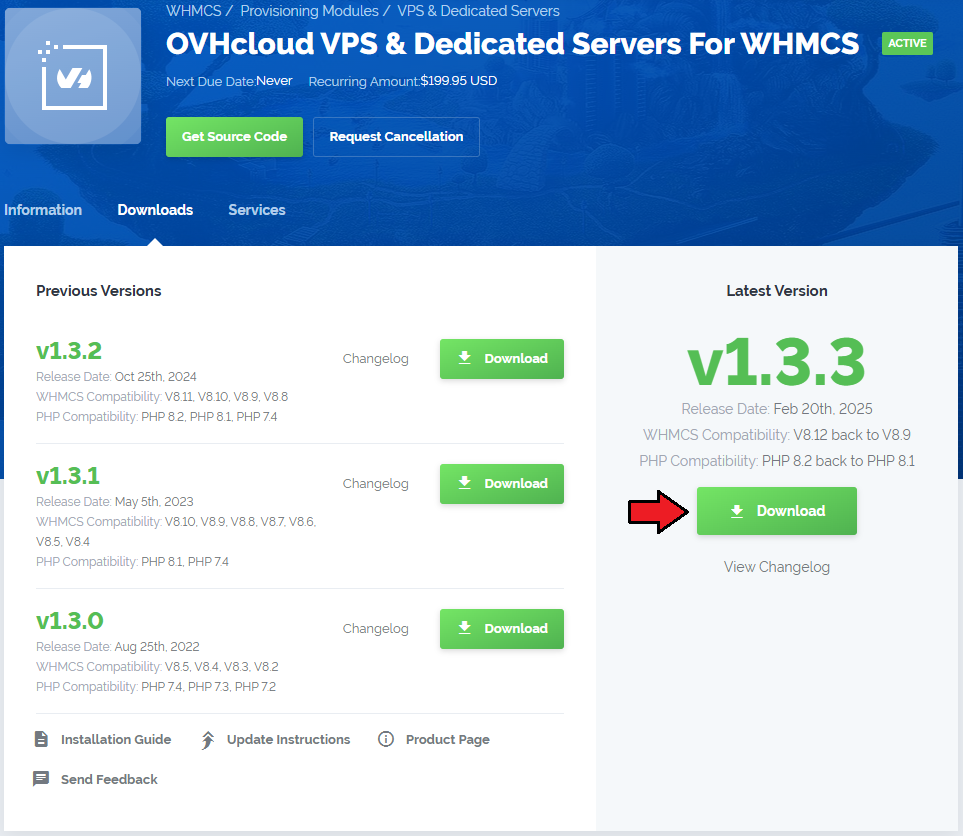
|
| 2. Upload and extract the extension into the main WHMCS directory. Extracted files in your WHMCS directory should look like this: |

|
| 3. When you install OVH VPS & Dedicated Servers For WHMCS for the first time, you have to rename the 'license_RENAME.php' file. The file is located in 'modules/servers/OvhVpsAndDedicated/license_RENAME.php'. Rename it from 'license_RENAME.php' to 'license.php'. |
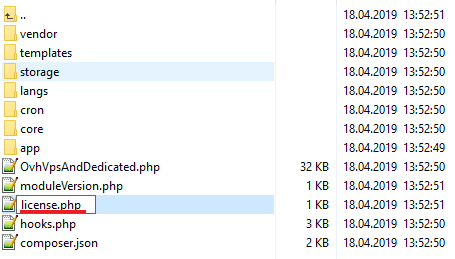
|
| 4. In order to configure your license key, you have to edit the previously renamed 'license.php' file. Enter your license key between the quotation marks as presented on the following screen. |

|
| 5. Now, set up the 'storage' folders as recursively writable. These folders are available at:
|
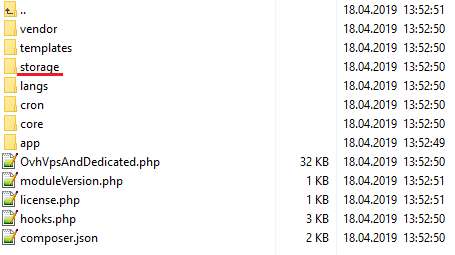
|
6. The last step is setting up the cron job.
php -q /your_whmcs/modules/servers/OvhVpsAndDedicated/cron/cron.php mail:run Remember to replace 'your_whmcs' with your WHMCS root path. |
Activation of Addon
| 7. Now you have to activate the module in your WHMCS system. Log in to your WHMCS admin area. Click 'System Settings' and find 'Addon Modules'. |
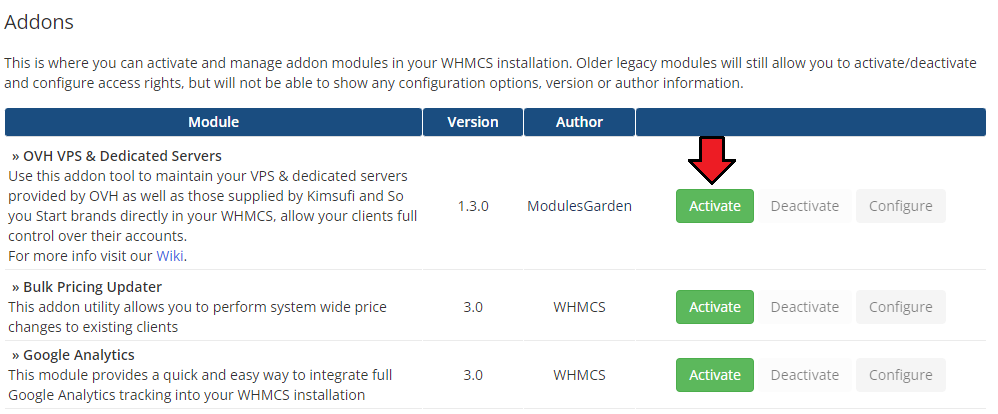
|
| 8. In the next step you need to permit access to this module. To do so, click on the 'Configure' button, tick the desired admin roles and press 'Save Changes'. |
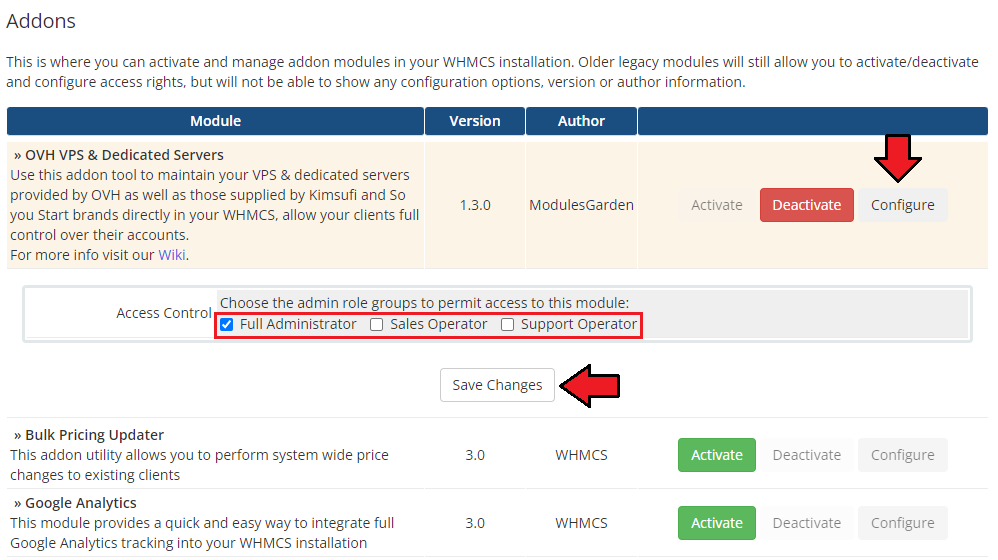
|
| 9. OVH VPS And Dedicated Servers For WHMCS has been successfully installed! Access the addon under 'Addons' → 'OVH VPS And Dedicated'. |
Configuration of Server
| 10. Now, we will show you how to configure a new product. Go to 'System Settings' → 'Servers' and press 'Add New Server' . |
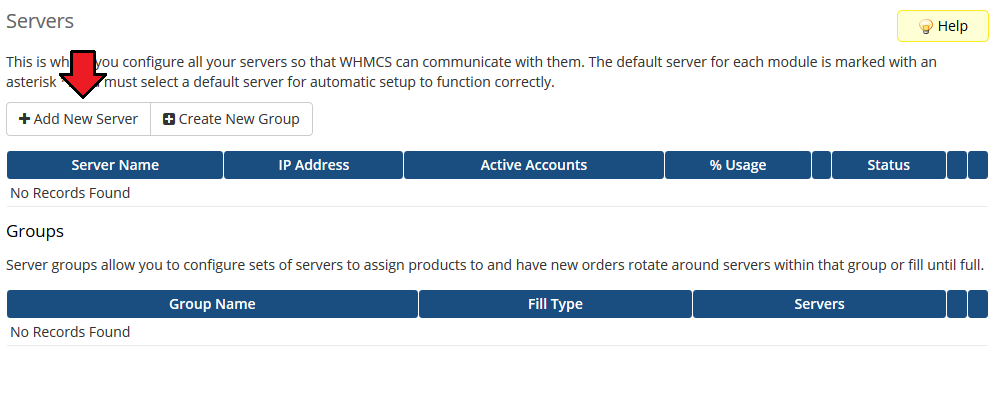
|
| 11. Next, enter your server name and select 'OVH' from the 'Type' field. Now, provide your:
Then select Location and Country corresponding with the server offered by the administrator and finally, select the OVH Server Type (VPS/Dedicated).
|
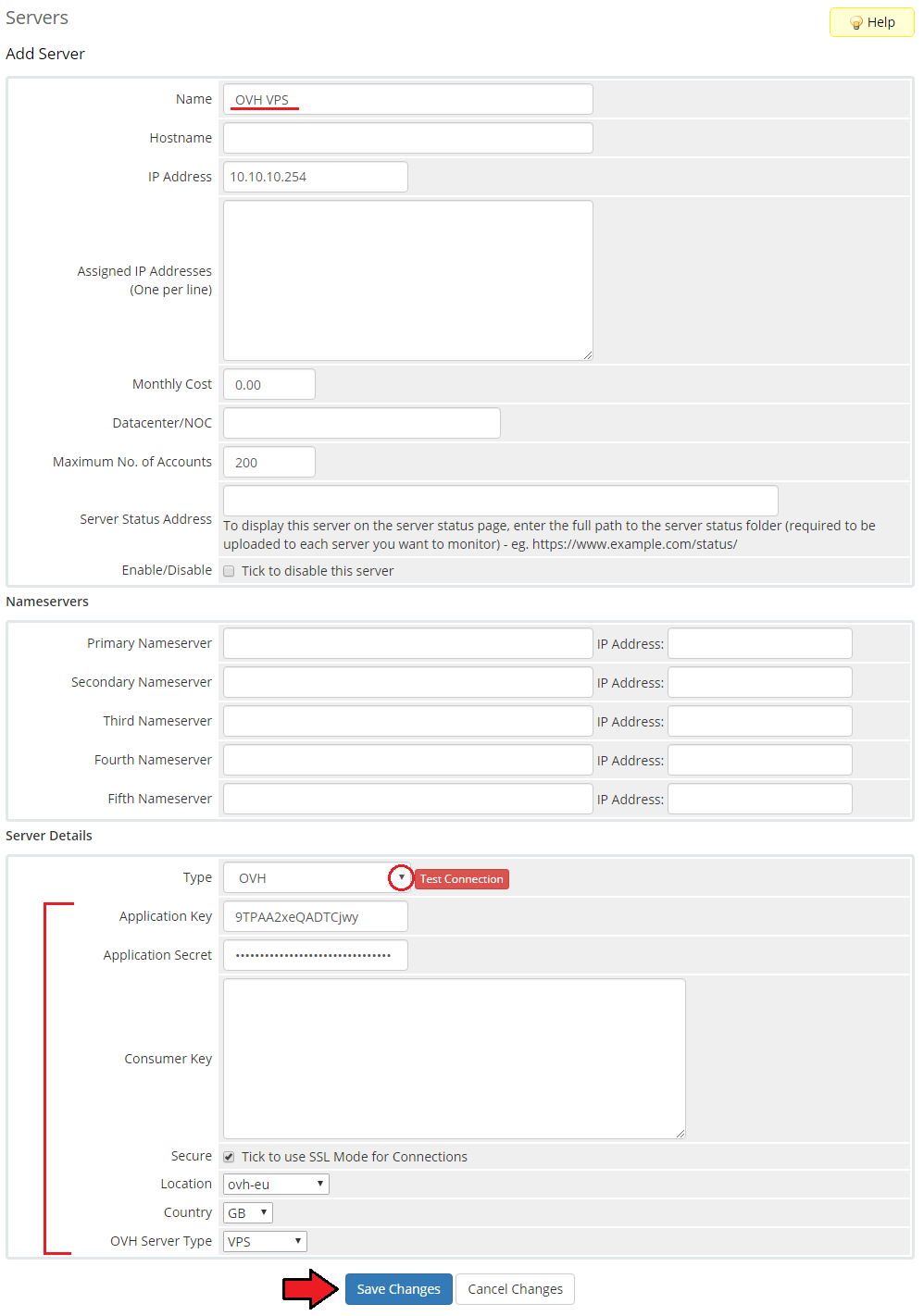
|
API details are generated depending on the location where you own the OVH account. These might be:
To create an application, please move directly here and create the necessary keys. |
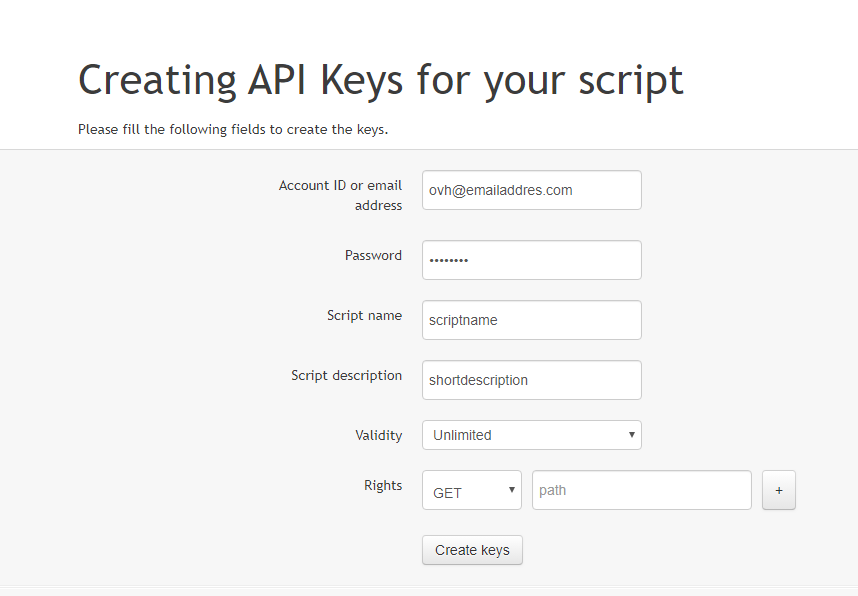
|
| You may also skip the 'Consumer Key' field in the server configuration (Application Key and Secret must be provided). After saving the changes, the module will redirect you, in such case, to your provider's page where the key can be generated at once. Please log in and select 'Unlimited' in the key validity field. |
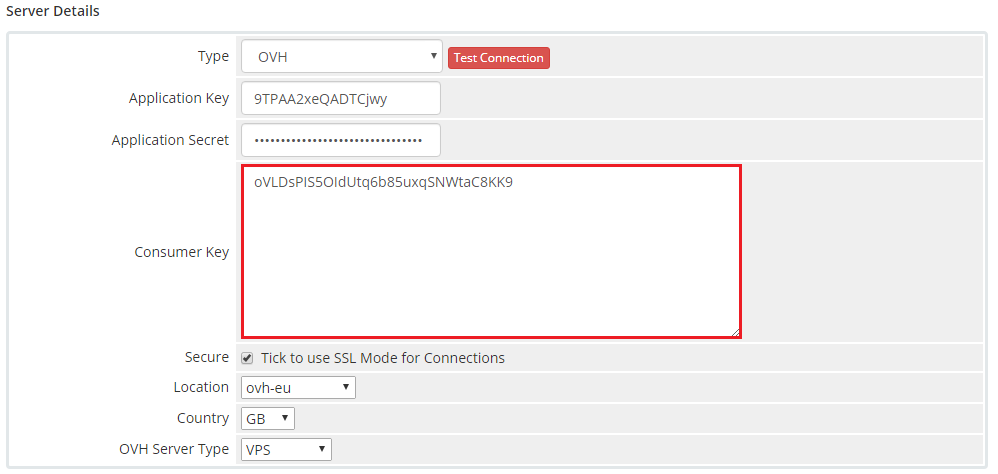
|
| 12. It is time to create a server group. To do so, click on 'Create New Group'. |
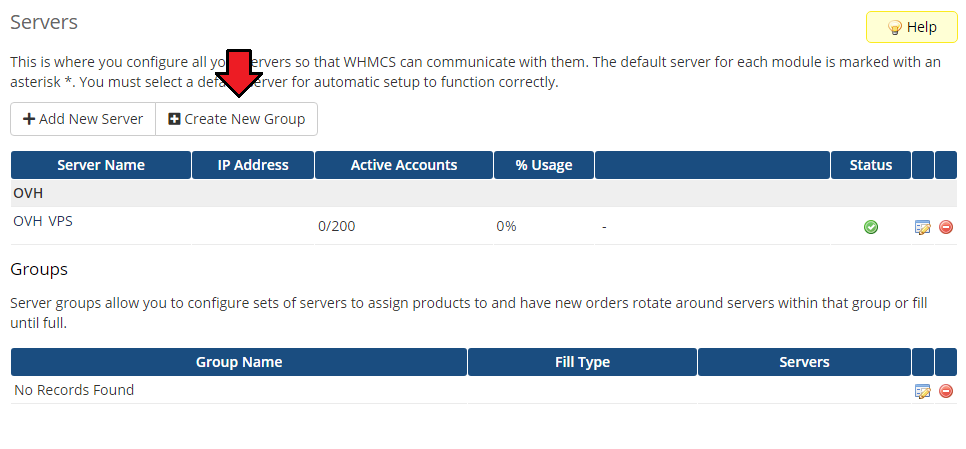
|
| 13. Enter a name, click on your previously created server, press 'Add' and afterward 'Save Changes'. |
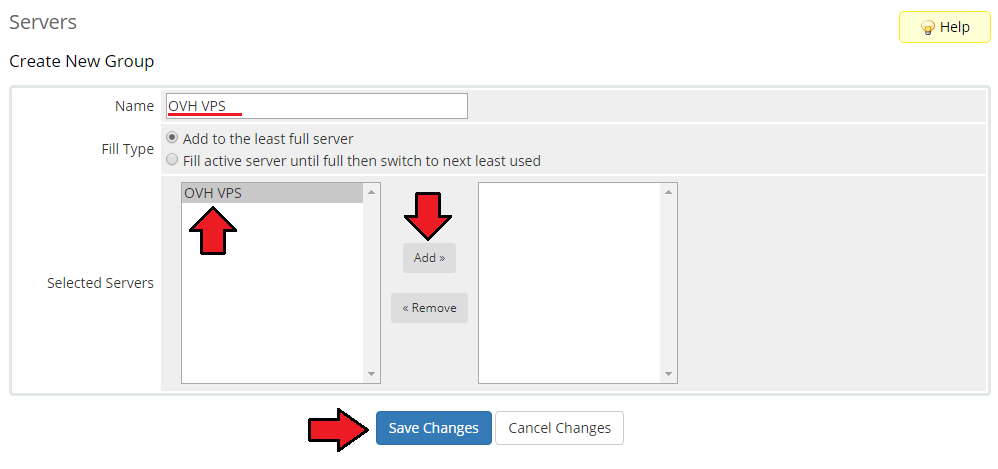
|
Configuration of Product
| 15. In order to create and configure a product, go to 'System Settings' → 'Products/Services'. Click on 'Create a New Group'. |

|
| 16. Enter your product group name and press 'Save Changes'. |
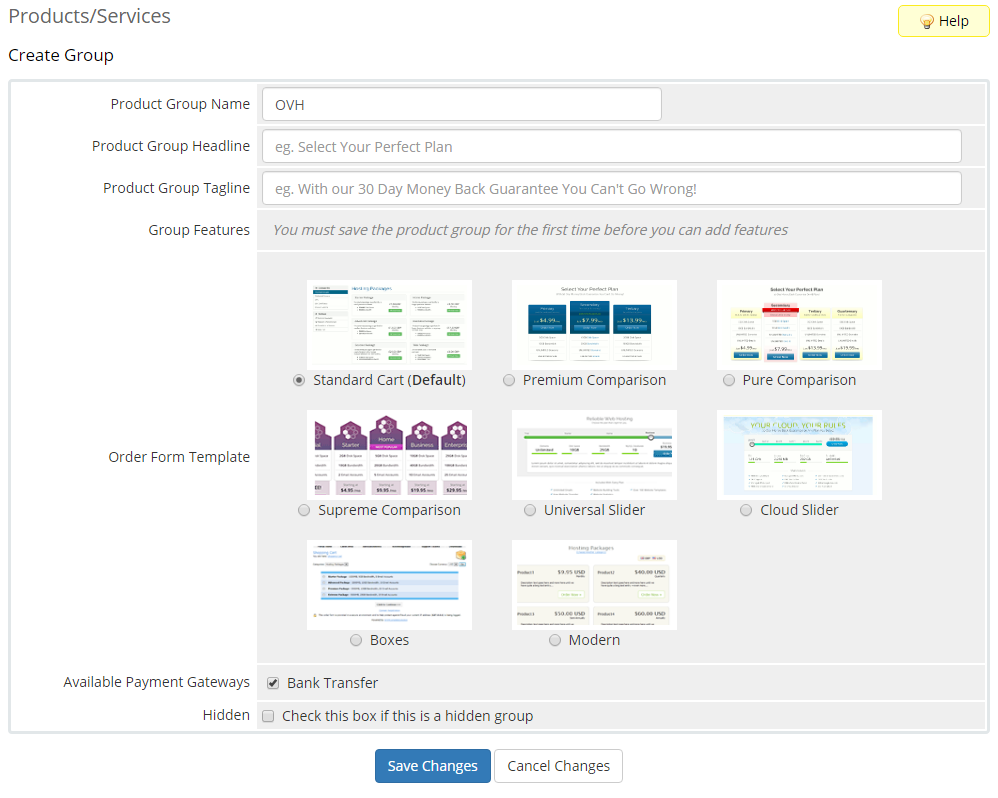
|
| 17. Once you have a product group, you can create a new product. To do so, first click on 'Create a New Product'. |
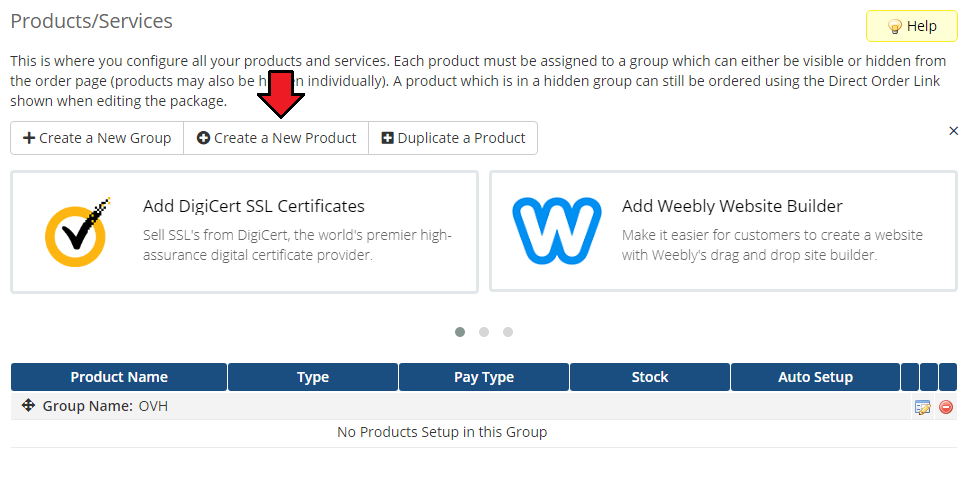
|
| 18. Afterward, choose your product type, enter your product name and choose the product group from the dropdown menu. Press 'Continue'. |
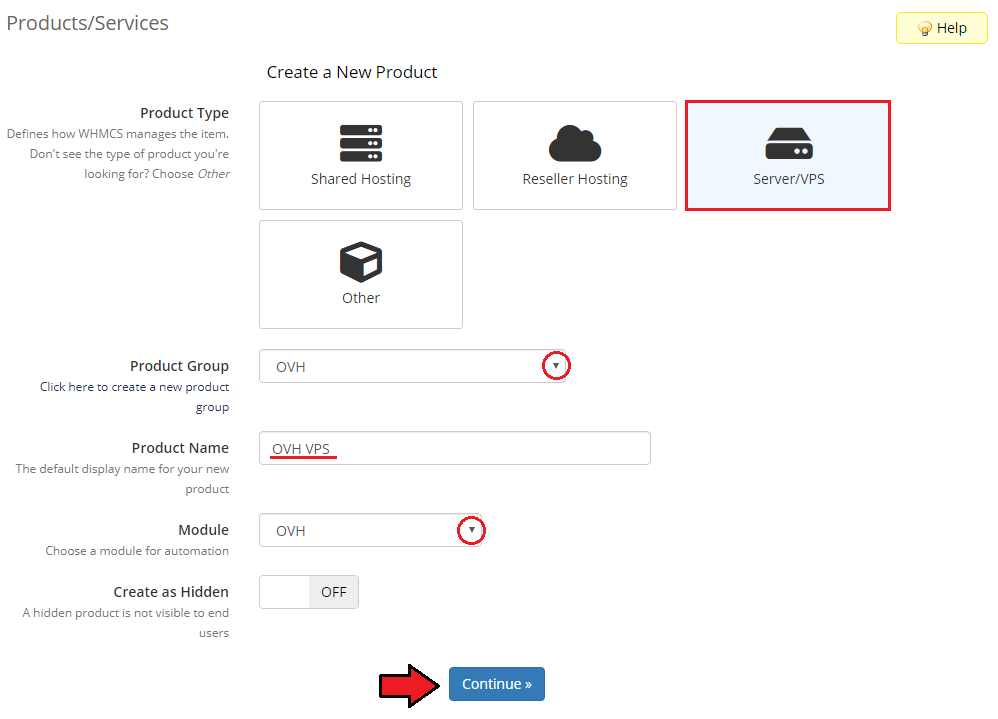
|
| 19. Now, go to the 'Module Settings' section, choose your previously created server group from the dropdown menu. The module should automatically save and reload the settings. If not, click on the 'Save Changes' option manually. |
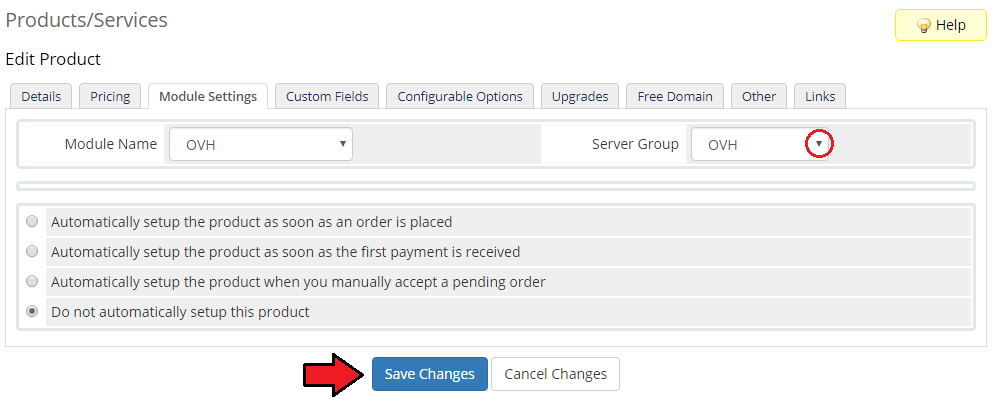
|
| 20. Now, you can start configuring the settings of the Server you sell. Bear in mind that the settings vary, depending on the server type selected. Underneath we will describe the settings configuration for 'OVH VPS' and 'OVH Dedicated Servers' in details. OVH VPS configuration settings:
|

|
OVH Dedicated Server configuration settings:
|
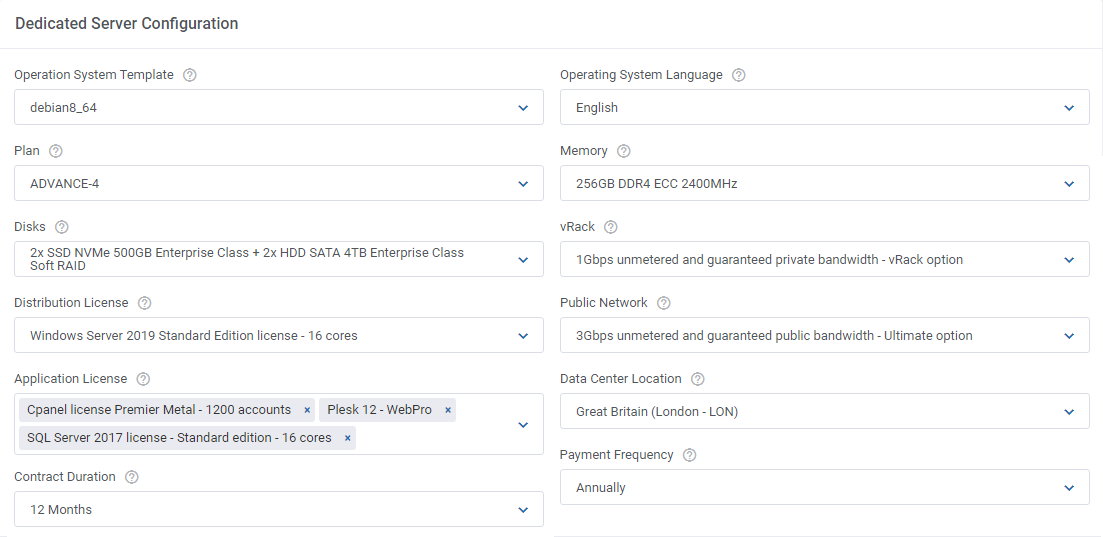
|
| 21. Afterward, set up incoming mail configuration. Due to API limitations, all emails with server credentials can only be sent to your OVH / Kimsufi / So You Start email address set in the panel. Note: Even though the module filters the received messages in your mailbox, we recommend that you use a separate mailbox for your main OVH VPS and Dedicated Servers profile account to avoid any issues with non-OVH content. After setting up the dedicated mailbox, provide its valid credentials below and test whether the connection has been established correctly. Note: There is available an option to 'Disable Certificate Validation'. Please toggle this option ONLY if you are having trouble with the connection. The certificate validation will be omitted when connecting to an email box. |
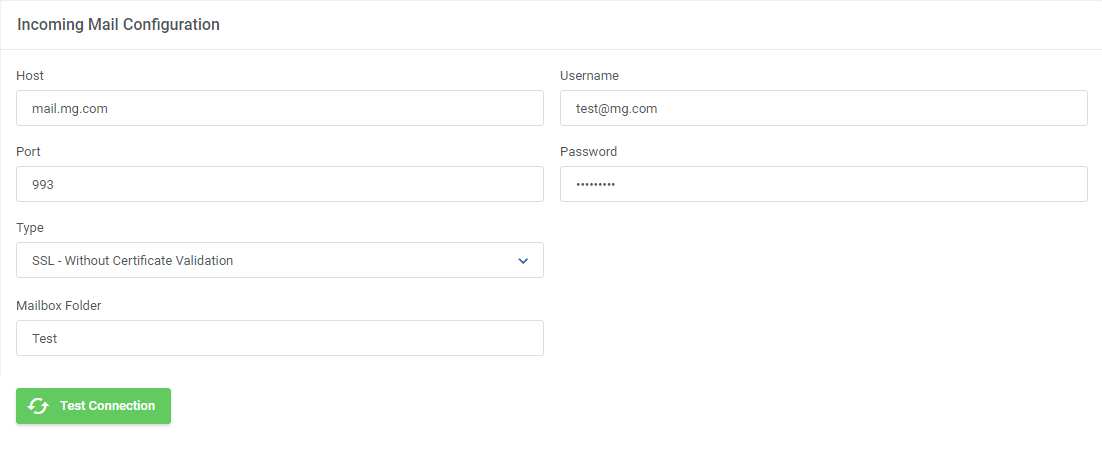
|
| The cron set during the last stage of the module's installation should periodically check that mailbox for OVH messages. If any new emails are received, they will be then converted to your email template and sent to the corresponding client. The default email templates for product creation, reinstallation and reboot in rescue mode can be specified below. Take a look at the Tips section - tip no 1, and check the templates' types. |

|
22. Automation Settings section includes detailed actions that will be automatically performed by the module in several situations:
|

|
| 23. The following section is dedicated to the Client Area Features. You will find here numerous options that can be enabled and then will be available to your clients in their client area. Please note that some options are available for VPS only, Dedicated Server only and some for both of them:
|

|
| 24. At the end of the configuration process, you can decide whether you want to generate configurable options for the product. Configurable options can be used by your clients to select each Server parameters individually during order placement. |

|
| If you decide to use configurable options, press on the 'Create' button and select which options you want to generate. Note that the configuration for disabled options will still be taken from the configuration of the main product. More information about how to use configurable options can be found here or in the official WHMCS documentation. |
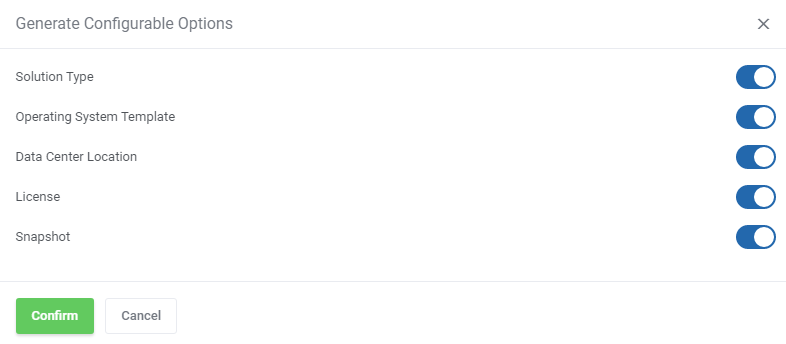
|
Generating Additional Configurable Option
| This section presents how you can manually add 'Solution Type & Operating System & Application' as additional configurable option in order to provide the diversity of your products. Proceed to 'System Settings' → 'Configurable Options' . Click on the 'Configurable Options' that were generated previously. |

|
| Click 'Add New Configurable Option' as presented below. |
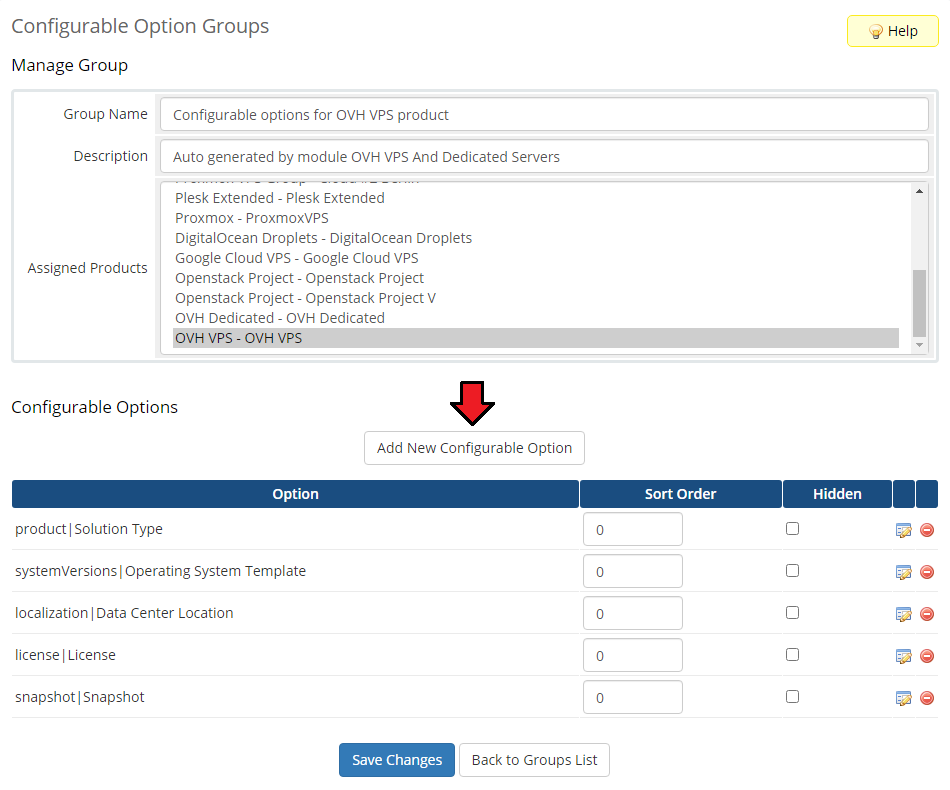
|
| Now, you need to provide 'planCodeVpsOsAddon|Solution Type & Operating System & Application' as 'Option Name' and choose 'Dropdown' as 'Option Type' . The first option has to be '0|None' . |
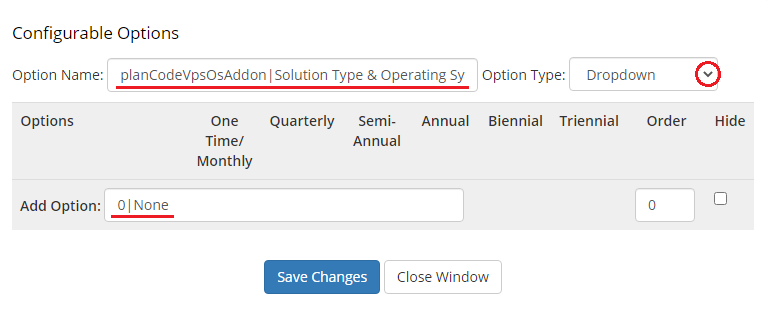
|
You can add another 'Options' following this scheme: product:OS:license|your name that is displayed to customers As an example, we will provide 'vps-value-1-2-40:Centos 7 - cPanel:option-cpanel-1|VPS Value 1 vCPU 2 GB RAM 40 GB disk - Centos 7 - cPanel (Option cPanel 1 account)' . |
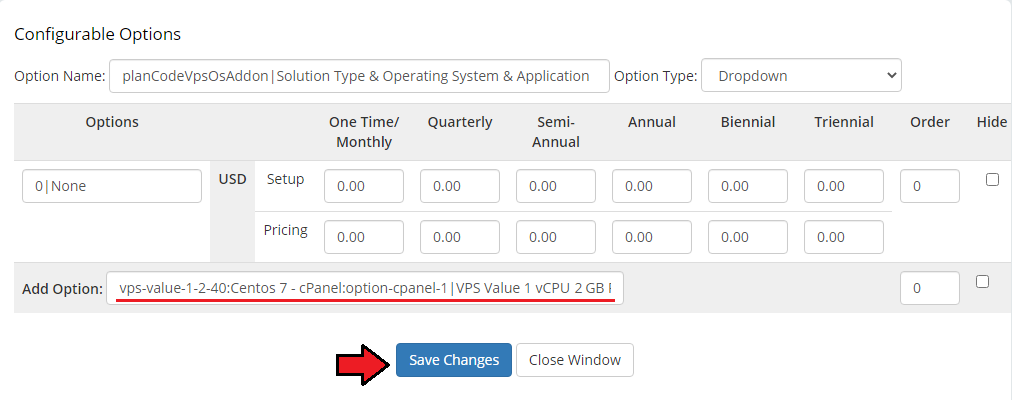
|
| If you wish to diversify your products, set different prices to make your products more competitive on the market. You can create another options using the following values. |
| Product | OS | License |
|---|---|---|
| vps-comfort-4-16-160 | Archlinux | option-cpanel-100 |
| vps-comfort-4-16-320 | Centos 7 | option-cpanel-200 |
| vps-comfort-4-16-80 | Centos 7 - cPanel | option-cpanel-30 |
| vps-comfort-4-4-80 | Centos 8 | option-cpanel-5 |
| vps-comfort-4-8-160 | Centos 8 - Plesk | option-cpanel-1 |
| vps-comfort-4-8-320 | CoreOS Stable | option-plesk-webadmin |
| vps-comfort-4-8-80 | Debian 10 | option-plesk-webhost |
| vps-elite-8-16-160 | Debian 10 - Plesk | option-plesk-webpro |
| vps-elite-8-16-320 | Debian 8 - Docker | option-windows |
| vps-elite-8-16-640 | Debian 8 - OpenVPN | |
| vps-elite-8-32-160 | Debian 8 - Plesk | |
| vps-elite-8-32-320 | Debian 8 - Vestacp | |
| vps-elite-8-32-640 | Debian 8 - Virtualmin | |
| vps-elite-8-8-160 | Debian 8 - WordPress | |
| vps-elite-8-8-320 | Debian 9 | |
| vps-elite-8-8-640 | Fedora 31 | |
| vps-essential-2-4-160 | Ubuntu 16.04 | |
| vps-essential-2-4-40 | Ubuntu 18.04 | |
| vps-essential-2-4-80 | Ubuntu 19.10 | |
| vps-essential-2-8-160 | Ubuntu 20.04 | |
| vps-essential-2-8-80 | Windows Server 2016 Standard (Desktop) | |
| vps-value-1-2-40 | Windows Server 2019 Standard (Desktop) | |
| vps-value-1-2-80 | ||
| vps-value-1-4-40 | ||
| vps-value-1-4-80 |
| Note: Please remember that the above options can be changed as plans are updated. You can easily check the currently available options by generating the default configurable options in the 'Module Settings' section. |
Configuration of Addon
| You have just correctly created and customized a new product. Go to 'Addons' → 'OVH VPS And Dedicated' in your WHMCS. |
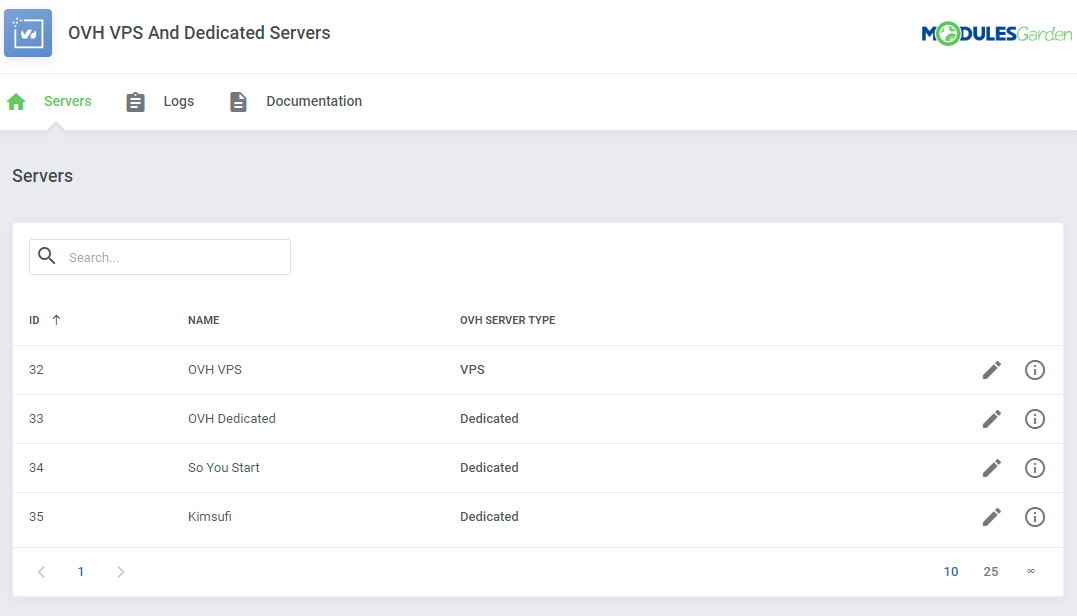
|
Servers
| 'Servers' section contains a list of your configured servers, you may quickly edit them directly from this site, simply press the edit icon. |
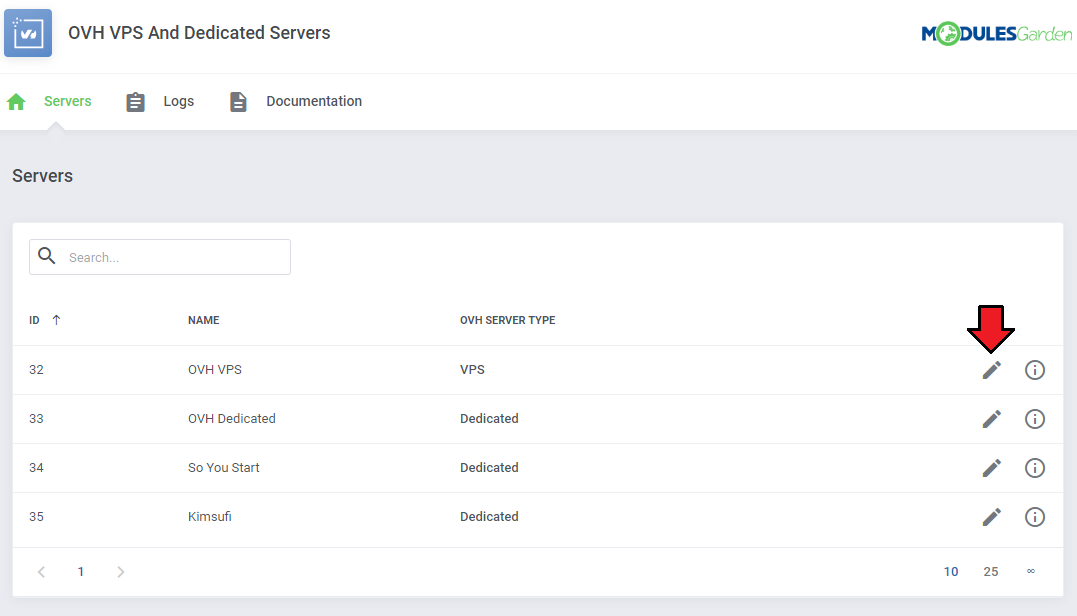
|
| In the next step, press the marked icon to see a list of deployed machines. |
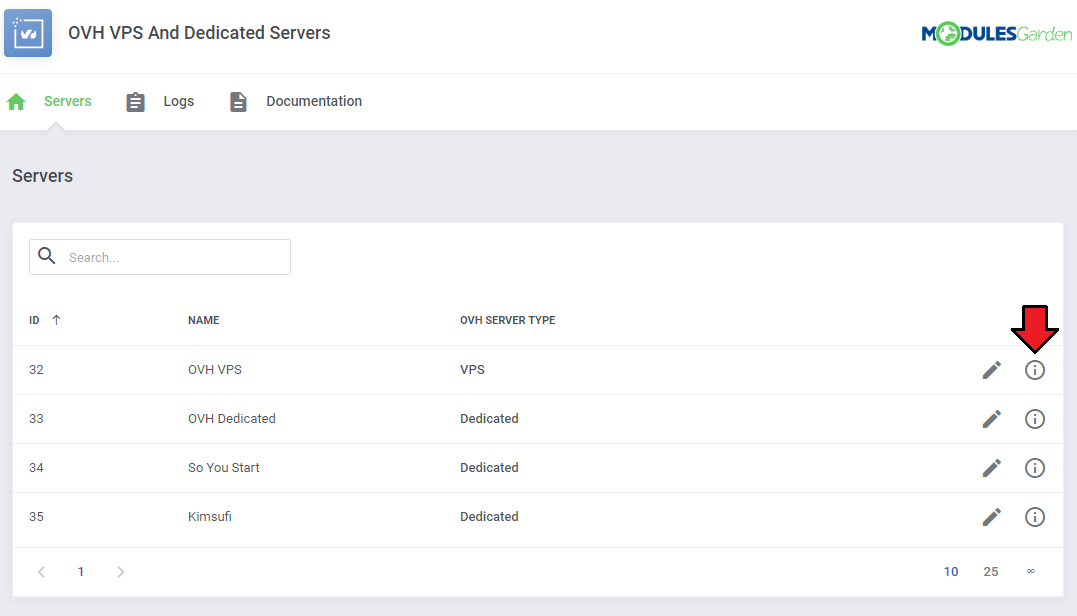
|
| There you will see all existing machines on this very server. Whether they are used by any client already or not. Next to the machine name, there are details such as:
In order to manually assign the machine to a client, simply press the marked on the screen button. |
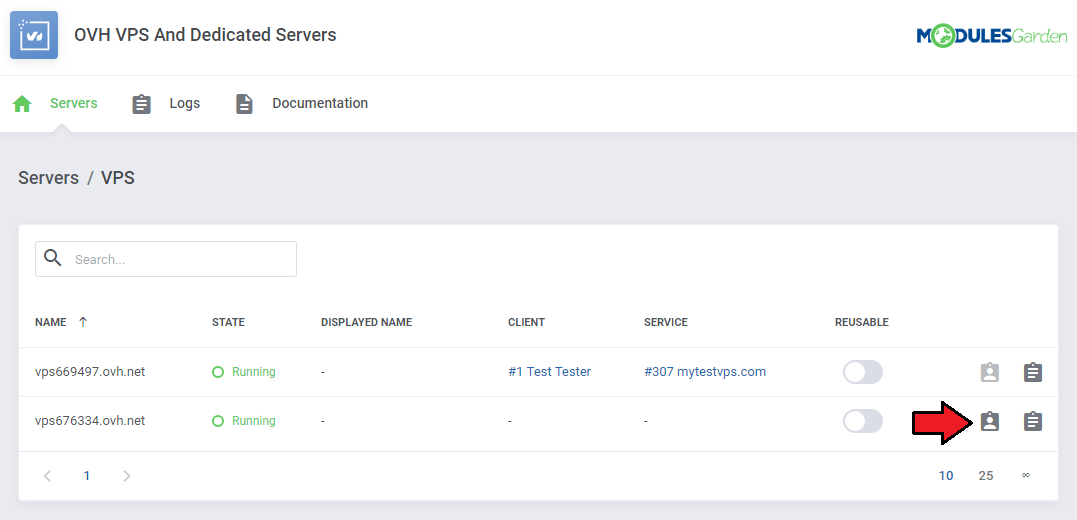
|
| Start typing to see a list of clients, then select existing service to assign. |
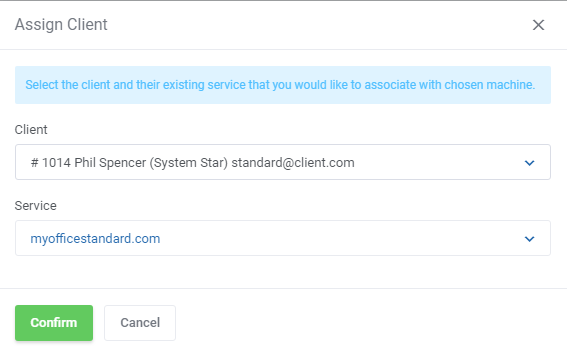
|
| There is also a possibility to assign reusable products to the machine. These products will be permitted to use this machine. |
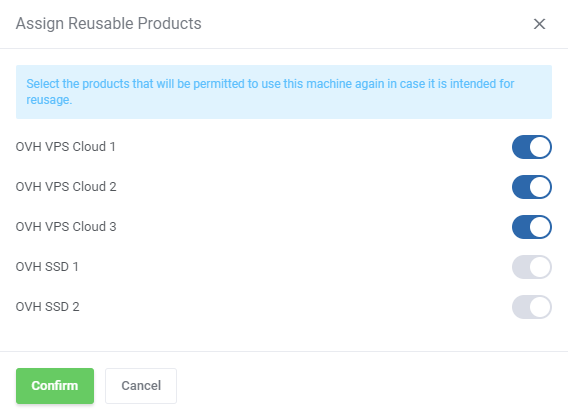
|
Logs
| Go back to 'Logs' section, there you will see a list of all module actions, including errors, notifications etc. |
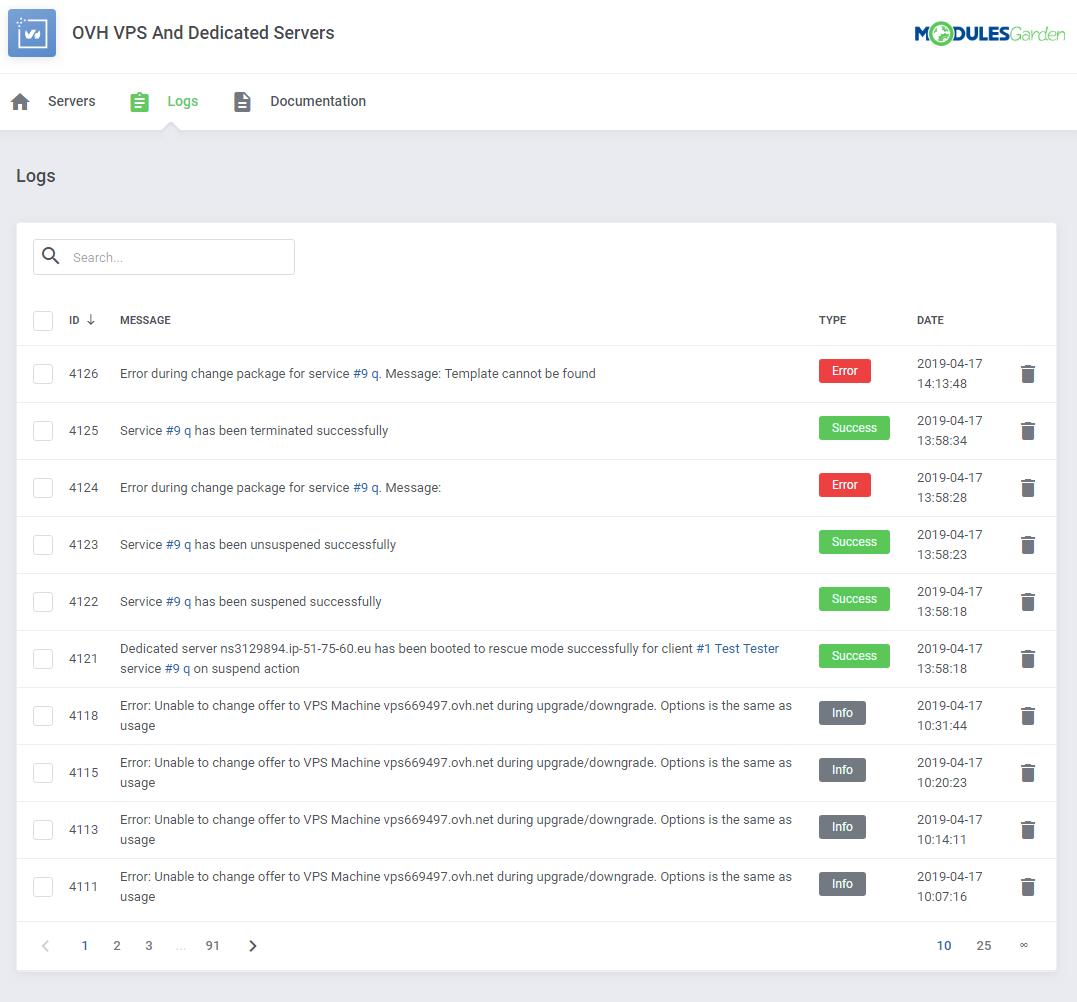
|
Management
Admin Area
| OVH VPS & Dedicated Servers For WHMCS allows you to monitor and manage your customer servers from the admin area of your WHMCS system. This includes supervision of such features like:
|
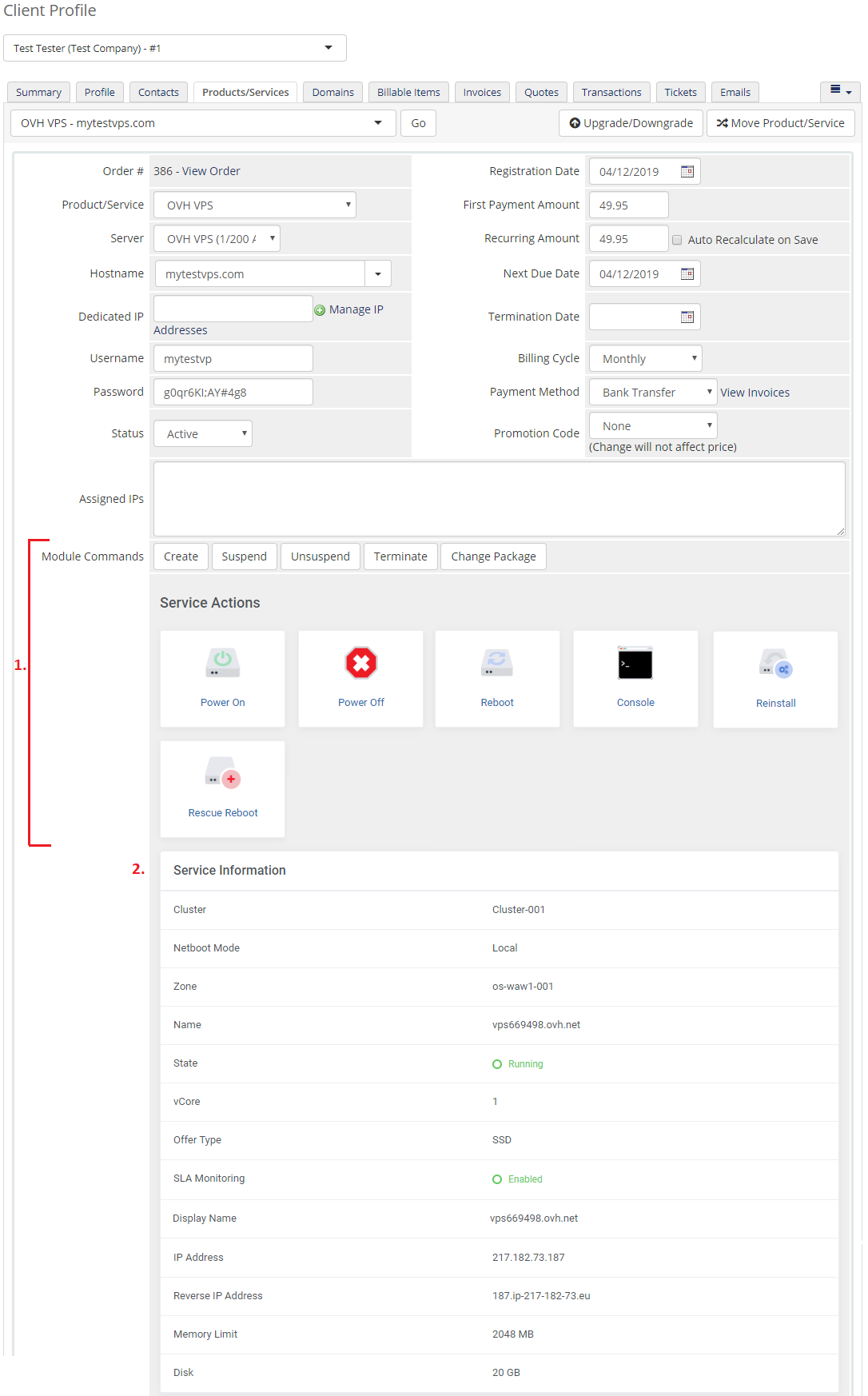
|
OVH VPS type
|
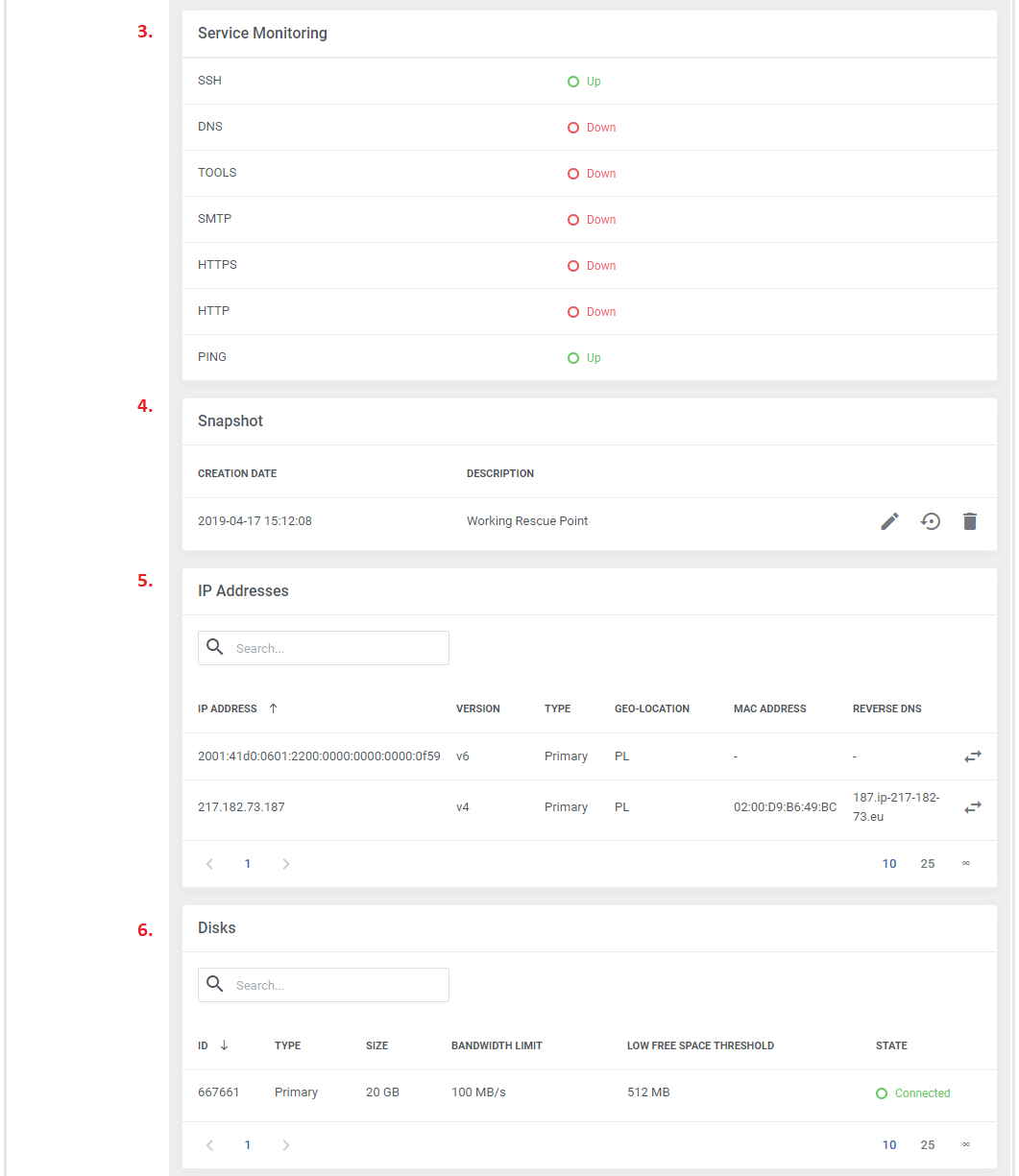
|
OVH Dedicated Servers type:
|
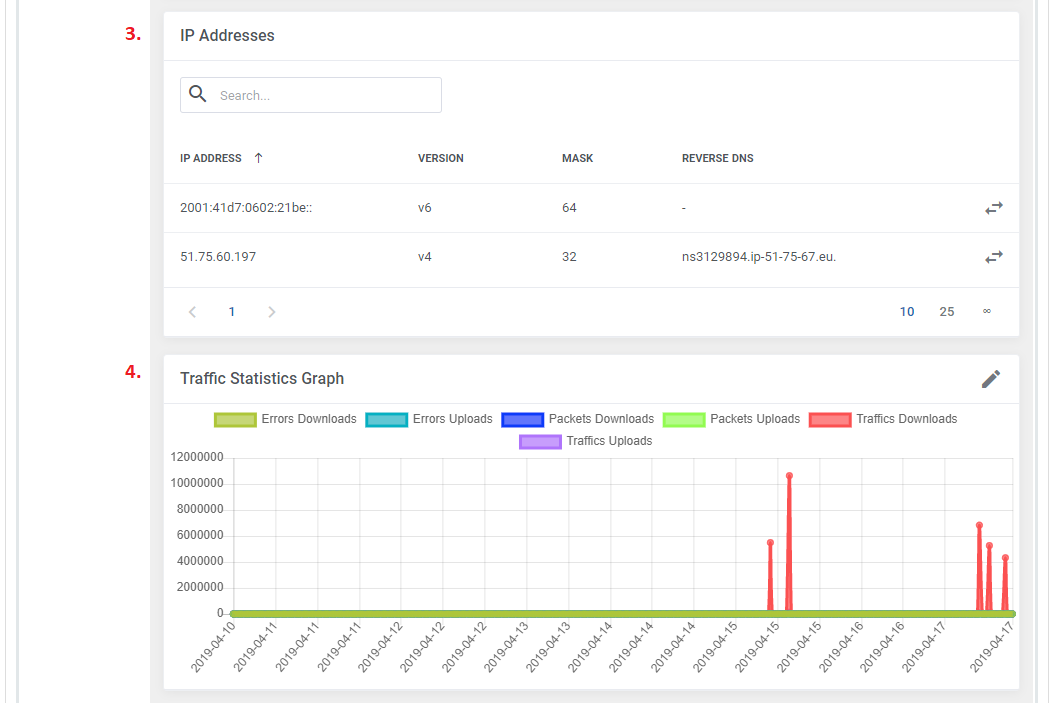
|
Ordering
| Owing to configurable options, you are able to offer a product which your clients can tailor according to their needs. Additionally, you are able to set up pricing for each configurable option, which makes your offer even more competitive. After the order placement and successful VM creation, the server credentials will be sent to the client's email address according to the set cron execution intervals. |
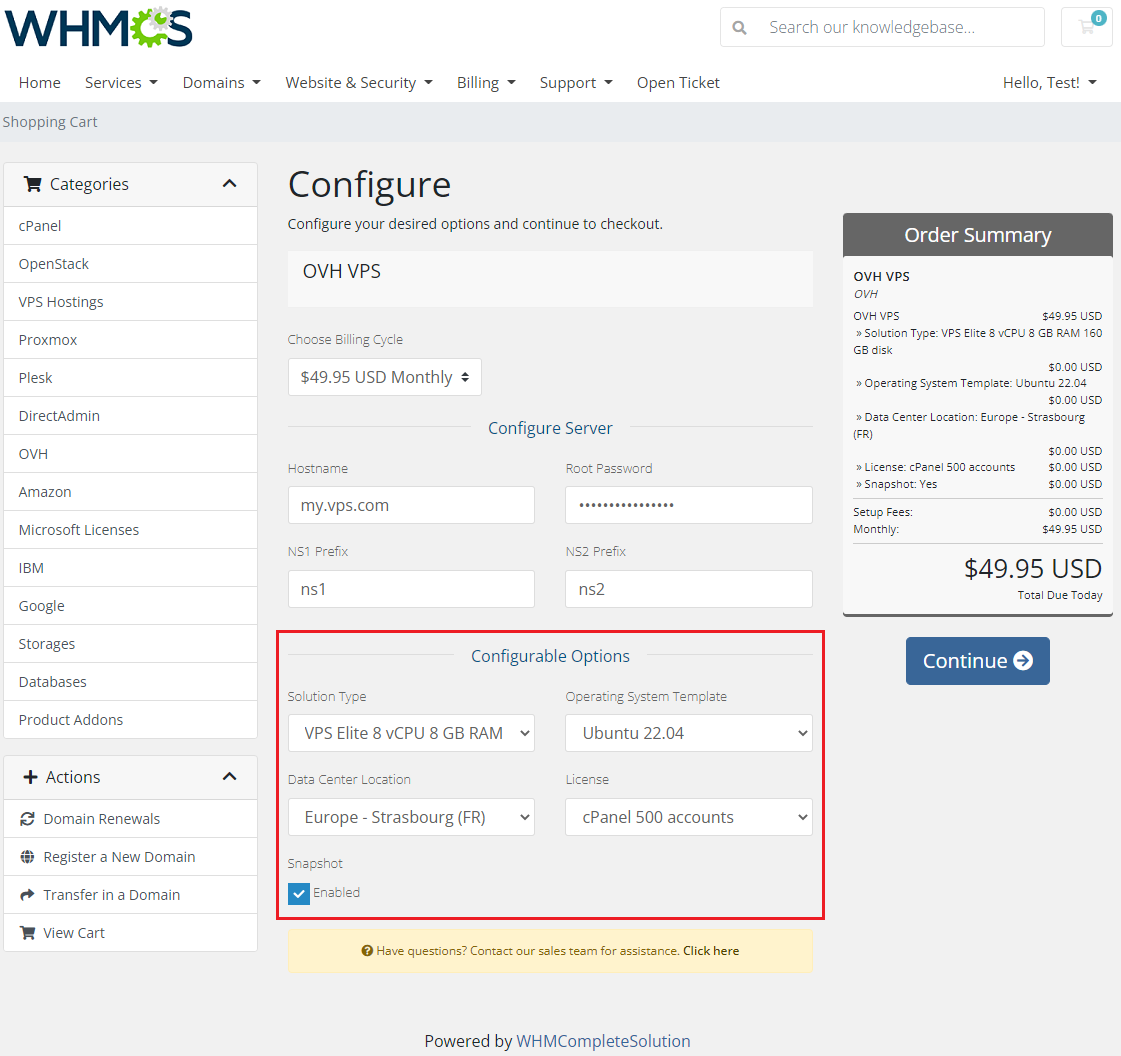
|
Importing Existing VPS
| In this section, you can find short instruction on how to connect one of your clients to your already existing VPS in the OVH panel. Take the following steps to make sure that the process will be carried out properly. 1. Firstly, manually create an order for your customer in WHMCS. Choose a client and in the summary, view click on the ' Add New Order' button. Next, select a 'Product/Service' and press 'Submit Order' .
The above-mentioned information has to be consistent with the data from your OVH panel. Now, complete this field as presented below. |
| 3. If the completed data is correct, after refreshing the page, you will see the attached VPS from OVH. Important! Remember to manually add other missing parameters of the VPS such as domains, IP Addresses, configurable options, etc. so they match the parameters of the attached VPS from the OVH panel. |
Client Area
| Client area interface of 'OVH VPS & Dedicated Servers' should look like the one on the screen below. As you can see, the control panel contains useful options required for managing a server. The module allows your customers to easily power on/off, reboot and reboot in rescue mode, reinstall and access console through pressing the corresponding buttons. OVH VPS client area view: |
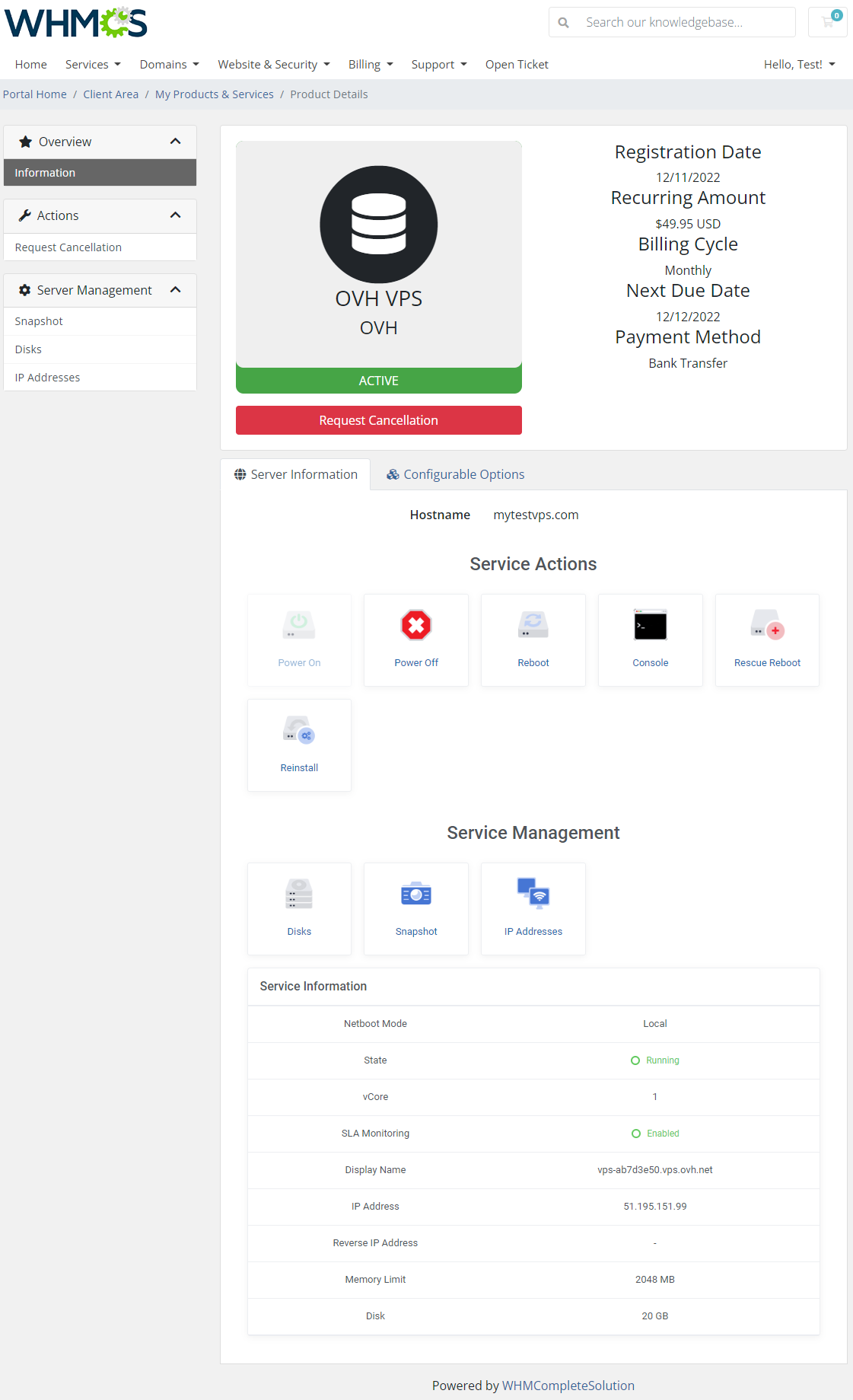
|
| OVH Dedicated Server client area view: |
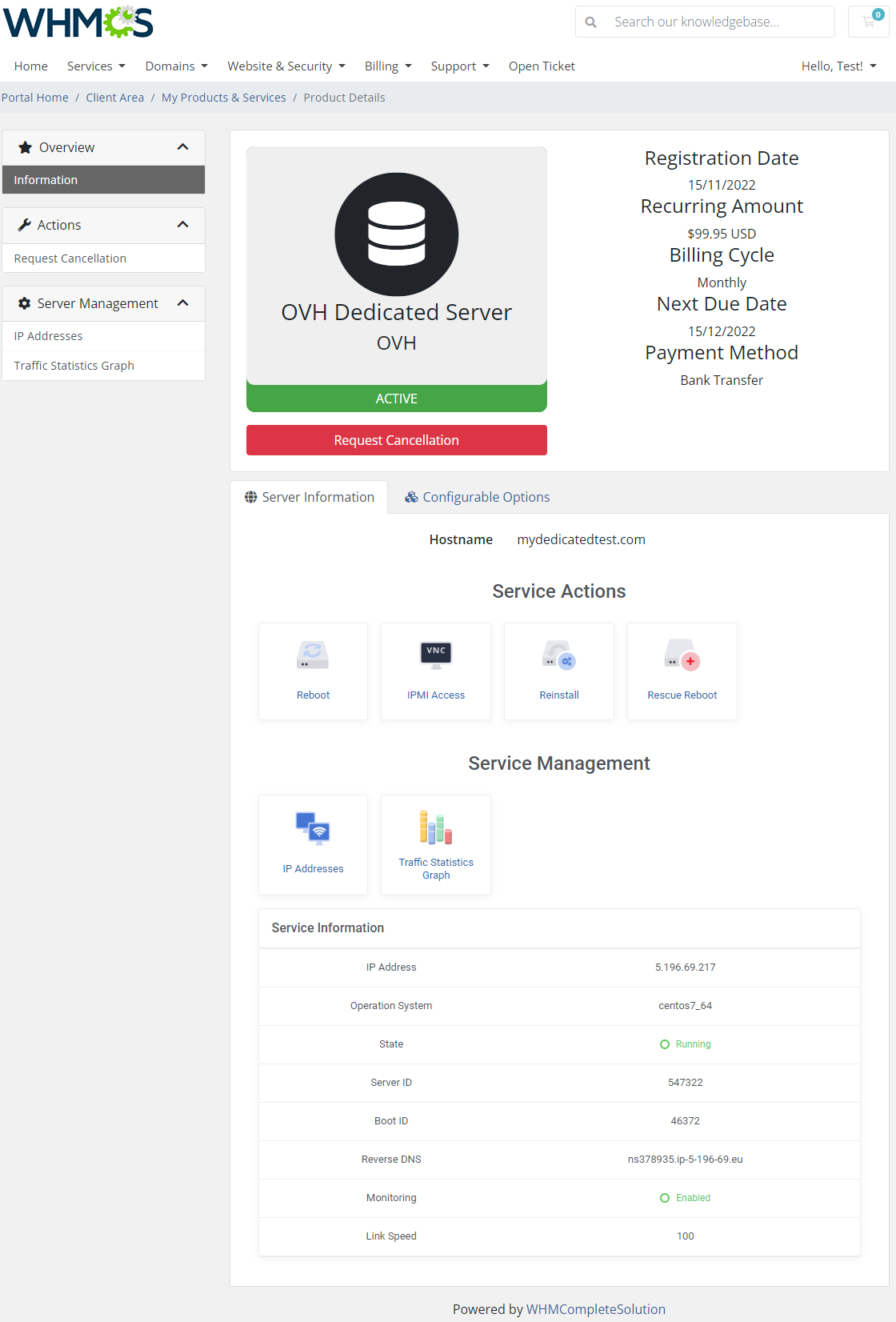
|
Service Actions
Access Console
| In case of OVH VPS, clients might be granted access to KVM console. Simply press its icon to open the console window. |
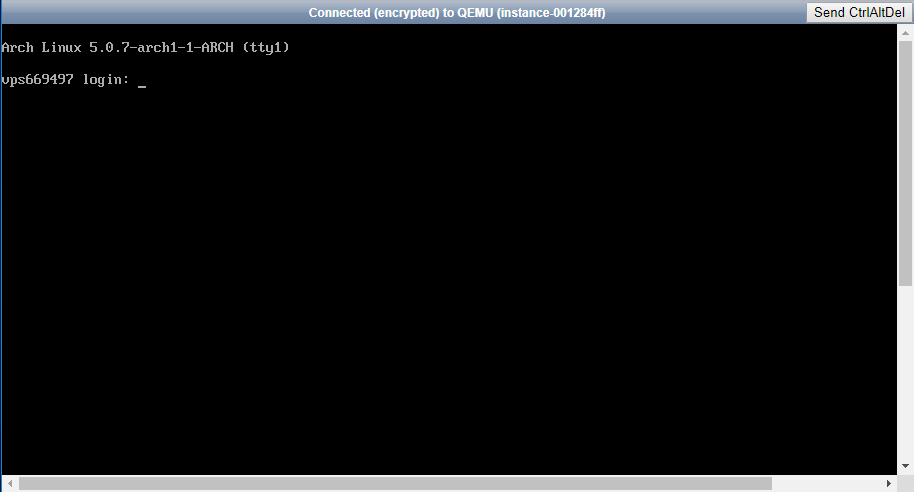
|
| For OVH Dedicate Servers, there is supported IPMI console. Press the IPMI Access icon and then select type and TTL of the IPMI access to continue to the console. |
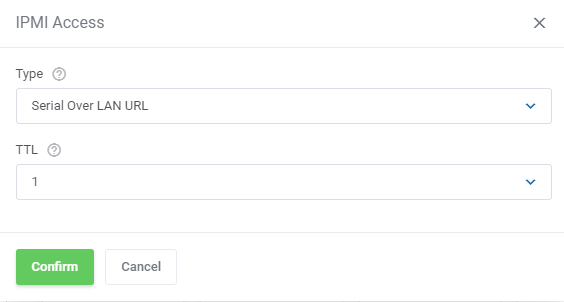
|
Rescue Reboot
| This action reboots the server in the rescue mode. The moment you press the confirm button, new login details are sent in an email template selected in the product configuration (see point 21), with accordance to the cron settings. |
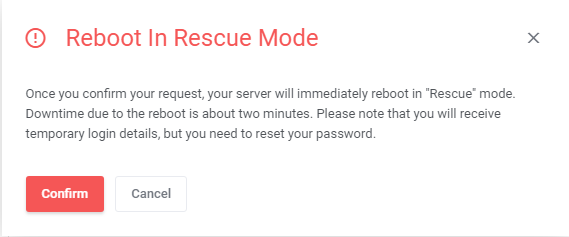
|
Reinstall
| The action when triggered, causes the new login details to be sent in an email template selected in the product configuration (see point 21) and with accordance to the cron settings. Note: Please be patient as reinstallation process is quite time consuming. |
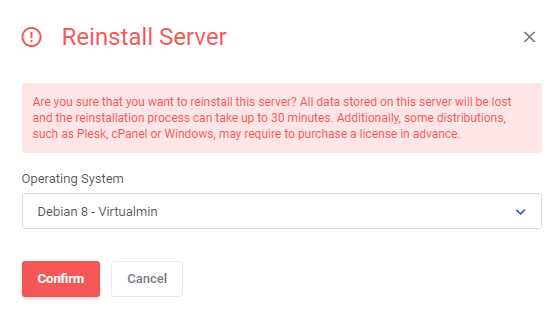
|
Service Management
Snapshot (VPS)
| Use snapshots to save the current contents of the virtual machine memory. You may use them later to restore the VM's settings. Note: Creating a snapshot may take a while, so it will not appear on the list right away. |
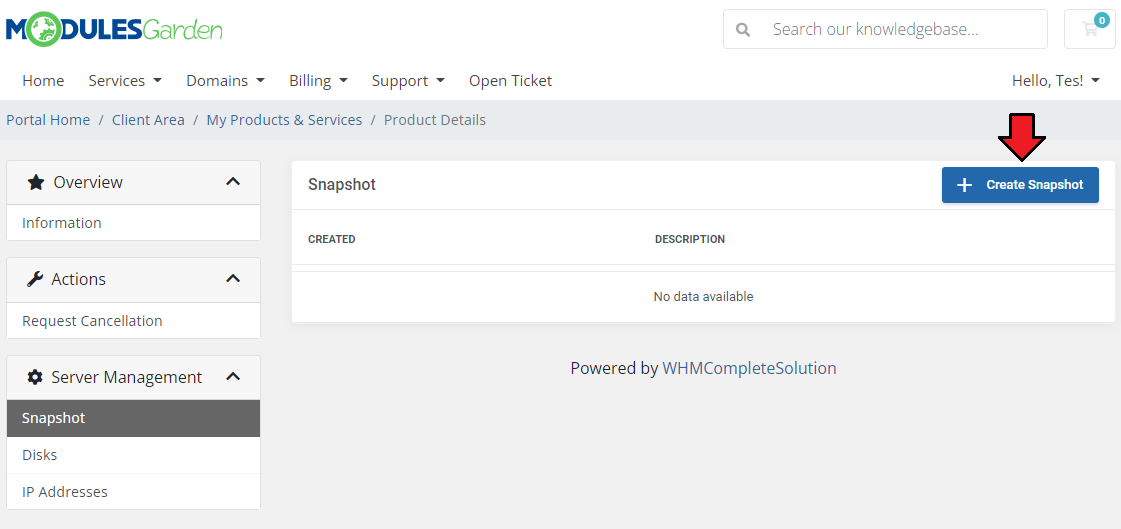
|
Allowed actions on the created snapshot:
|
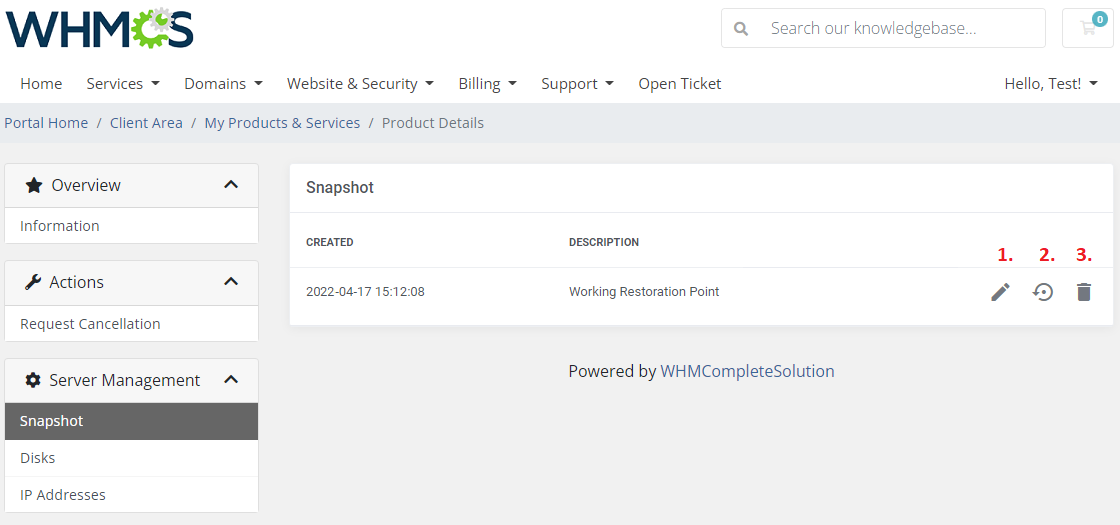
|
Disks (VPS)
When you enter this section, you will see a list of assigned disks with any details on them, such as:
|
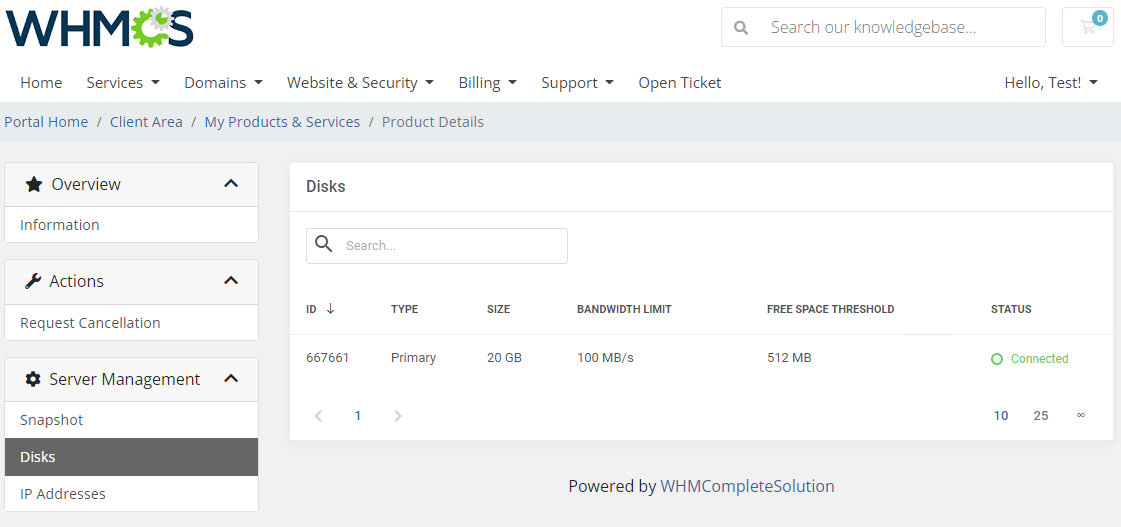
|
IP Addresses
| Under 'IP Addresses' you may see any assigned IP addresses, their version, type, location, MAC address and reverse DNS if specified. Update the reverse DNS path of an IP address by pressing the marked button. |
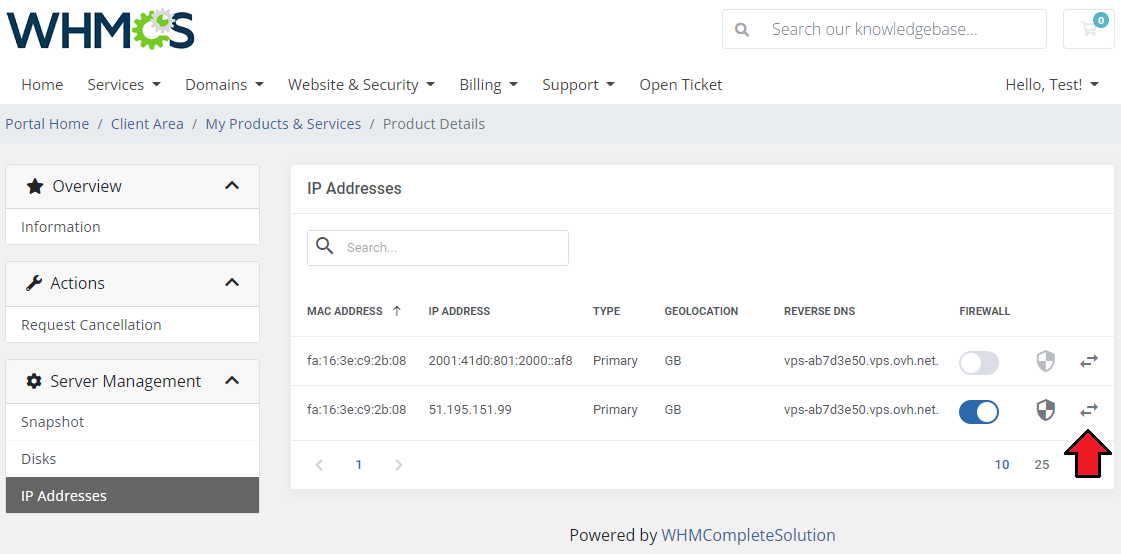
|
| Provide a new reverse DNS for the selected IP address. Press 'Confirm' when ready. |
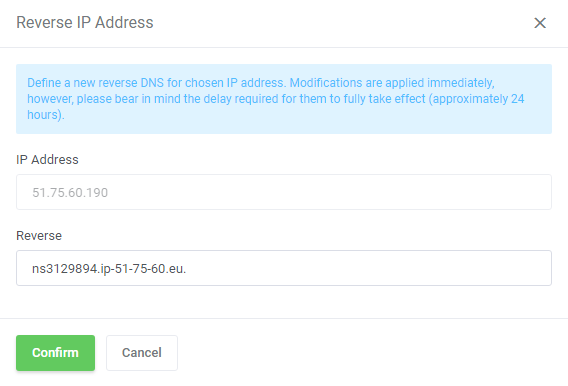
|
Traffic Statistics Graph (Dedicated Servers)
| Open this section to see the graph with traffic statistics. You will find there outlined data on errors, packets and traffic downloads as well as uploads. You may easily adjust the graph's view by changing the time scope of the displayed stats. Note 1: Some of the mentioned option may not be visible on the graph until soma data are generated. This is applicable to the graph itself as well. |
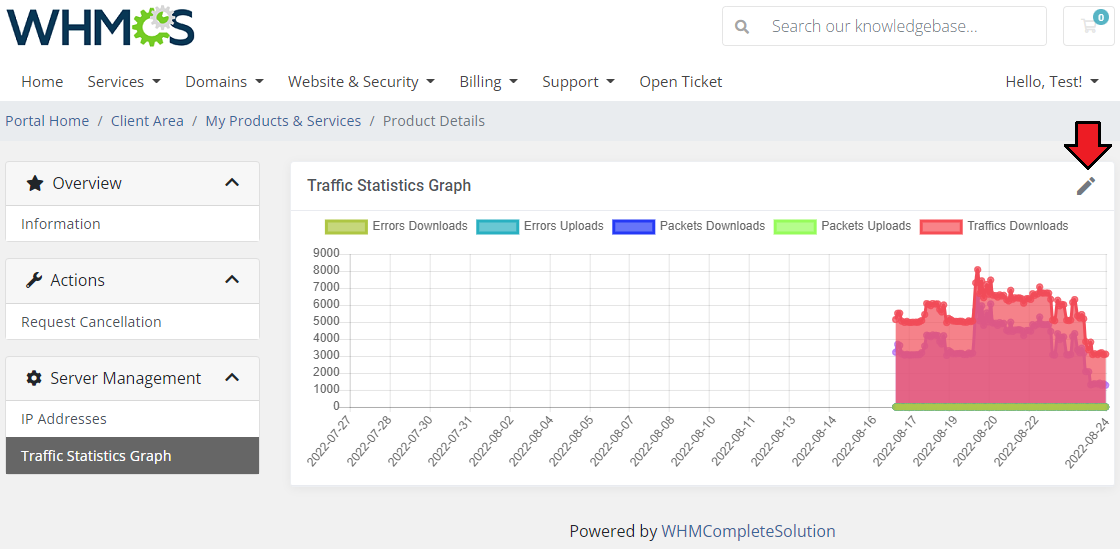
|
| Select the time scope: |
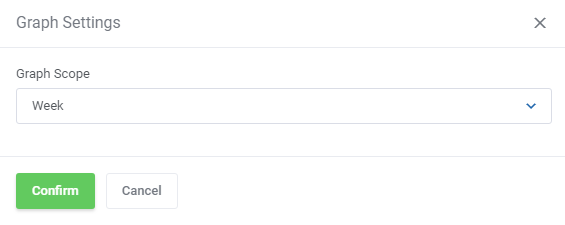
|
Tips
1. List of 'OVH VPs & Dedicated Servers' email templates included in the module:
In order to view the templates' content and edit it, please move to WHMCS → System Settings → Email Templates. 2. If you want to block specific OS images which are available for the server reinstallation process, you need to add these OS images to the following file: |
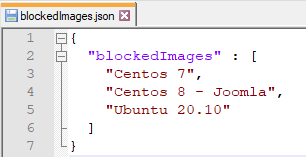
|
Update Instructions
| Essential guidance through the process of updating the module is offered here. Keep in mind there is a quick and easy option in our client area that will let you upgrade the license of your module to an open source version at any time - and at a lower price! |
Common Problems
| 1. When you have problems with connection, check whether your SELinux or firewall does not block ports. |
| 2. You may encounter problems while configuring the product for the dedicated server type for 'So you Start' or 'Kimsufi' brands. As a consequence, options such as plan to configure in the module settings can be unachievable. Please note that this is most probably caused by API problems on the side of these brands. However, it is still possible to assign the ordered server directly from the panel of these brands to the client's product at WHMCS by providing its 'Server Name' in the ordered service in the admin area. |
| 3. If you encounter error in logs: Error during create for service #name_of_your_service. Message: Your preferred payment method is not valid Solution: Please log into your OVH panel and set up a default payment method there. |